Special thanks to the major advocate and OG holder of Loot @Taylor Zhang, and to the active contributor of Dark Forest and core member of DF Archon @byeddy. Their invaluable guidance and patient responses to the author's inquiries have allowed for a clearer and more profound understanding of both ecosystems. Gracias!
Author: Kaspar Chen @Mask Network
1.Prologue
The concept of blockchain games has existed since the earliest days, and one could argue that without the imagination and exploration of gaming on the chain, we wouldn't have the blockchain as we know it today.
After all, the seed for the towering tree that is Ethereum was planted through a centralized game's "raid" on players. During a time when Blizzard nerf the Warlock, a once bright-eyed young Warlock cried himself to sleep. This led to the creation of Ethereum, and a world with one less Warlock, but countless new possibilities.
As we fast forward in time, we can see that the genesis of the now-critical ERC-721 standard for the encrypted world emerged from a game called CryptoKitty, which caused the first serious congestion on the Ethereum network. It also inspired the emergence of the X2E pioneer, Axie Infinity, heralding a new era.
With the wealth-generating effect of the NFT wave in 2021 and the momentum of the BSC ecosystem, numerous projects have turned their focus towards gaming, an ever-popular area. The concept of blockchain games has once again been brought to the forefront, and we have entered a seemingly fast-paced period of growth for gaming on the chain.
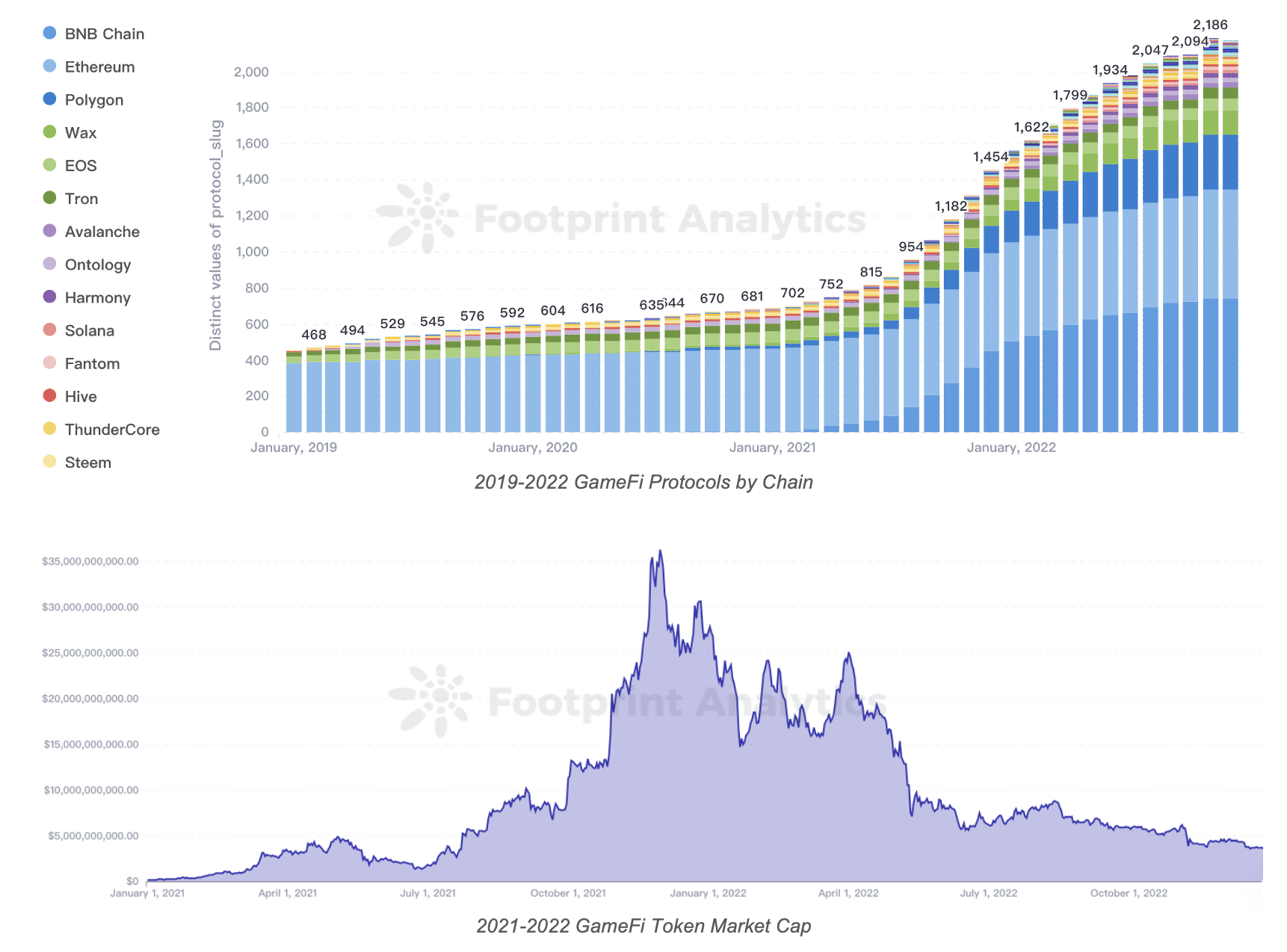
However, as we approach the year 2023, we are faced with over 2,000 blockchain games, only 700,000 daily active users with an unknown ratio of real human to bot, and a market value that has plummeted to rock-bottom levels. Have we truly realized our vision of blockchain gaming? It is difficult to give ‘Yes’ as we survey this landscape, strewn with the corpses of X2Earn games.
2. What is Fully On-Chain Game
2.1 What exactly is 'GameFi'?
Attempting to pinpoint the reasons for their failures is an arduous task, as each individual has a different definition of success. Perhaps, in some sense, these games achieved their own measure of success. What everyone is truly interested in understanding is why they failed to survive and how blockchain gaming as a new emerging industry can better thrive in this environment.
Going back to the early days of blockchain gaming, the term "GameFi" gained popularity due to a tweet by the CEO of Yearn Finance, Andre Cronje, a prominent figure in the DeFi field. In September 2020, he expressed his fascination with the idea of incorporating gamification mechanisms into the monetary policy system. He believed that this concept could transform the environment dominated by TradFi projects at the time and make DeFi more scalable and gamified.
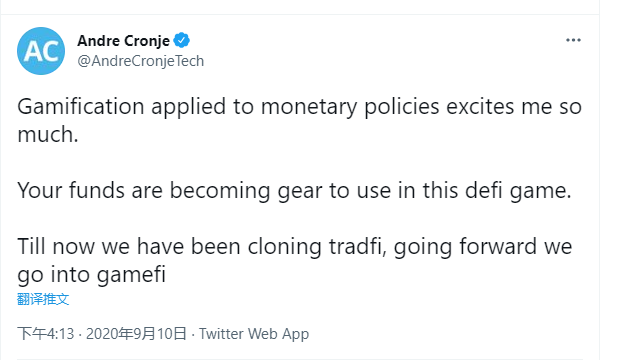
Therefore, at that time, two strategies emerged:
-
The first one is DeFi gamification: combining DeFi and NFTs, the core is still the staking and yielding mechanism but adding a layer of NFT in between, such as Aavegotachi and Meme at that time;
-
The second one is gamifying DeFi: by reducing other parts of the game to strengthen the economic model, aligning game behaviour with staking and yield farming, which became known as Play2Earn. Essentially, this is liquidity mining, and the most popular example at that time was Axie Infinity
Regardless of the strategy, the core was always centred around Fi, and the user base was always DeFi users with a focus on ROI.
However, the explosion of Axie still successfully attracted many game practitioners and even players themselves, who thought that if a game with such extent of content could succeed, so could they. Thus, the market was flooded with GameFi projects, claiming themselves the truly decentralized game, using the name of Game to Fi everyone, and after all, saying that there are only speculators in the blockchain world.
Some of the people behind these projects simply did not care, while the majority of those who did care were never able to fully grasp that GameFi was never really about gaming. Gamification and Game are two totally different things at the fundamental level.
2.2 Different Approaches of Blockchain Games
If we briefly break down a game's modules, we can roughly divide them into three parts:
-
Narrative part: This includes the game's universe background and character stories, which establish the player's motivation. Even simple casual games can have a highly influential narrative, as seen in Angry Birds.
-
Core game logic: This is the main part of the player's interaction, which is designed through the game engine's various elements and rules. It also includes the backend calculations and rendering.
-
Economic model: This includes the logic of production, consumption, and linkage with external currencies (fiat) of game assets and currency.
2.2.1 On-Chain Assets Game
The majority of blockchain games today mainly focus on modifying the economic model by putting currency and (parts of) assets on the chain. However, the core game logic and calculations, as well as the narrative and governance, are still centralized. According to Jump Crypto's research, these games are referred to as "On-Chain Assets" games (OCA).

In this scenario, putting currency and assets on the chain, apart from increasing the asset circulation efficiency, does not have as significant an impact as one might expect. Centralized control could still make players' holdings worthless easily, and when the project actually rug, the so-called permanent assets would still have how much value remain?
2.2.2 Optional Cosmetic Mints Game
There is another type of game that has less association with blockchain and is still used by some games. This model is often used by traditional games that want to enter web3 in a very short time during the early days.
In the OCM model, everything is the same as in traditional web2 games. Both the issuance of assets and currencies is managed in a centralized manner. However, players can mint some of the assets they hold into NFTs and achieve free circulation. At the same time, the game studio would also sell some passes/features in the form of NFTs.

The aforementioned two types of games can be called games that use blockchain technology, but clearly have a distance from decentralized blockchain games. Therefore, after understanding the current situation, more and more attention is drawn to truly decentralized games: fully on-chain games.
2.2.3 Fully On-Chain Game
The concept of fully on-chain games refers to games where all the interactions, behaviours, and states are fully on-chain, and the core game logic and economic models are also processed via the blockchain. In other words, the blockchain serves as the game's server, and all player actions are completed by interacting with smart contracts. Even the game's narrative and governance can be decentralized through DAOs, allowing for a truly decentralized game.

The field of fully on-chain games is still in its infancy, but some interesting games have already emerged, such as Conquest, MuMu by @Tropology, Treaty by @0xCurio, 0xMonaco by @Paradigm, and not to mention the once very popular Wolf Game. Among them, there are two giants that cannot be ignored in this field: Dark Forest and Loot.
3. The Peerless Twins: Dark Forest
Dark Forest was inspired by the famous science fiction novel "The Dark Forest" from the "Three-Body Trilogy" and is the first fully on-chain incomplete information game.
3.1 Background & History
As a space-based MMORTS game, it can accommodate thousands of players to explore, build and conquer each other in an infinite, procedurally-generated, cryptographically-specified universe, with all players' actions and states updated on the chain but not publicly shared.
The original idea and founder of Dark Forest was @Gubsheep, who happened to attend a conference which focused on zero-knowledge proofs and was impressed by Liu Cixin's theory of the dark forest, so he came up with the idea of creating a "cryptographic dark forest" by applying the zkp. (Note: Mask Network team helped Brian contact the copyright owner of the Three-Body Trilogy -- 'YOUZU', and gave him a signed copy of the book by Liu Cixin.)
At first, this was just a highly experimental idea. As a high-frequency interactive application, games faced huge challenges in the blockchain environment. Moreover, applying zero-knowledge proofs to such a complex system was a thing that had never been done. However, Dark Forest not only realized their concept, but also became a milestone in the history of blockchain.
The early Dark Forest team was mainly composed of Gubsheep, @Alan (Sir Waddles), @Ivan, and @Moe.
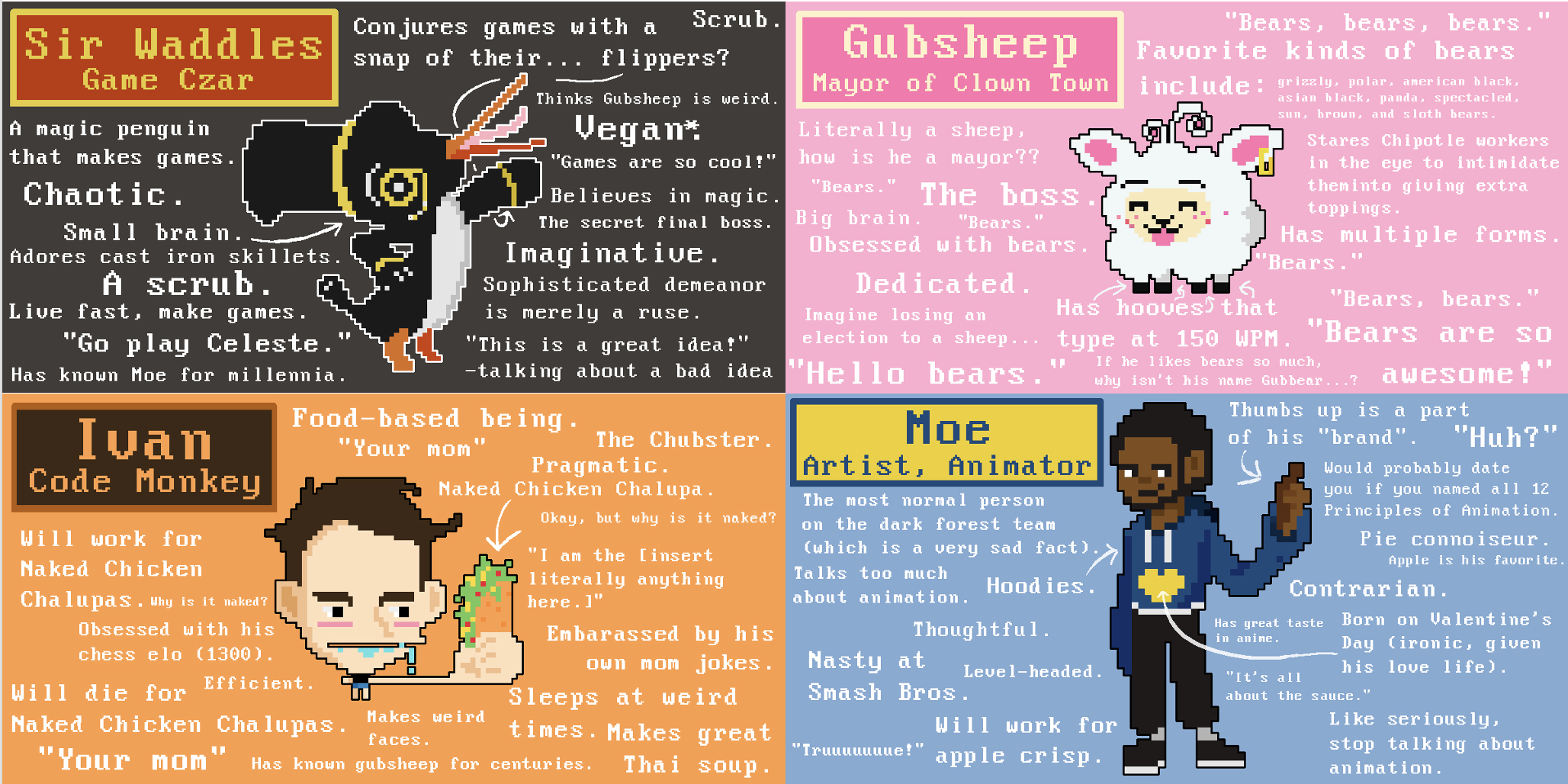
the first official test version Dark Forest v0.3 was released on August 7, 2020, and was deployed on the Ropsten testnet. To join the game, players needed to obtain early access invitation codes. After one week of testing, the version was reset. Players were ranked according to the scores they accumulated during the testing period, and the top 15 players were rewarded from a prize pool of 1024DAI, with the first-place player receiving a reward of 256DAI. Shortly after its release, V0.3 was personally recommended by Vitalik Buterin.
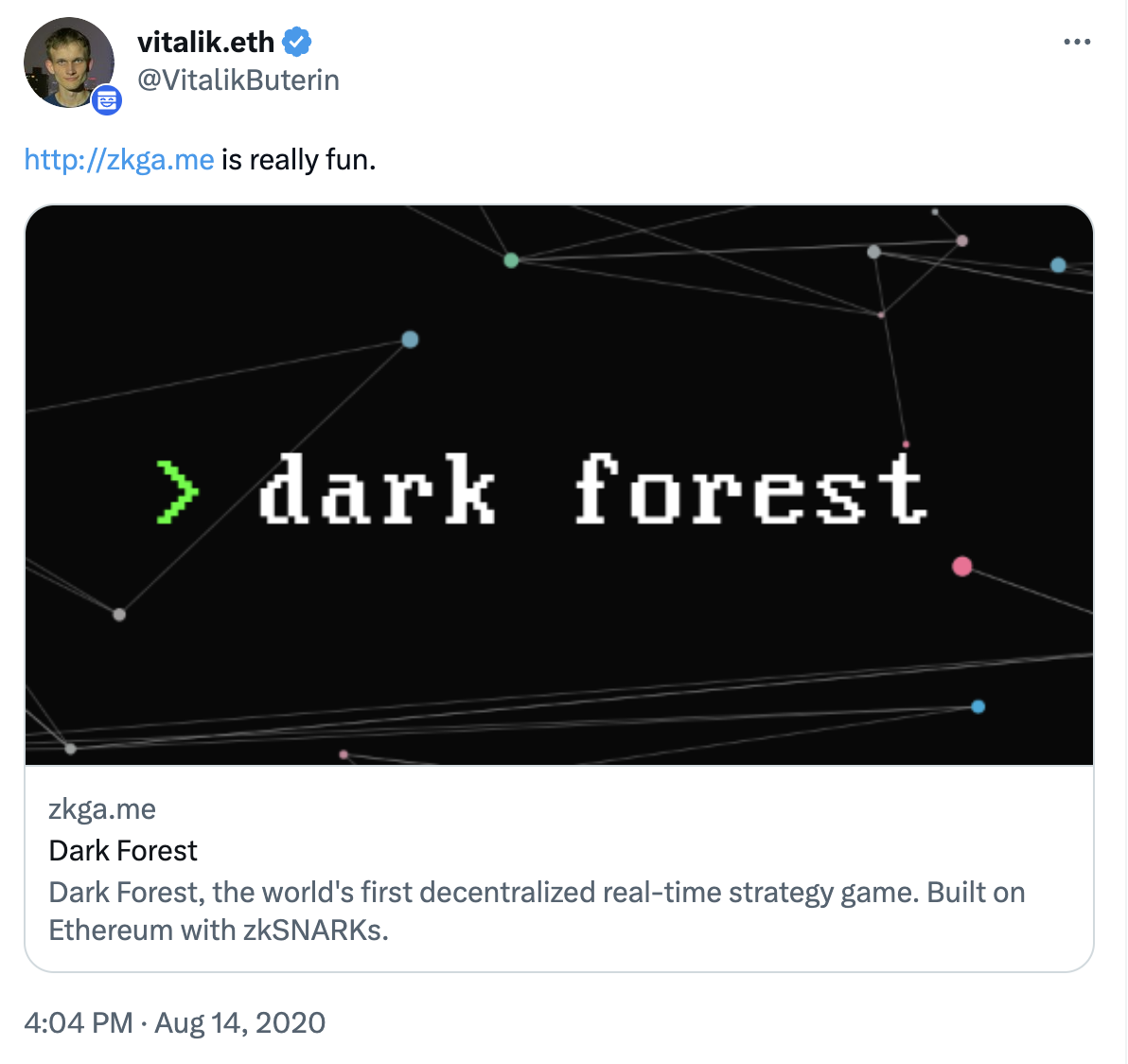
As the community grew, more members and volunteers joined, including community members such as @Scott Sunarto, @spencecoin.eth, @Andy , who made outstanding contributions to the development of Dark Forest.
On October 2, 2020, Dark Forest v0.4 was officially launched, which was deployed on the xDAI STAKE network and could accommodate twice as many players as v0.3. This version first used the Burner Wallet (a one-time wallet), and the open time was increased to 10 days. Similar to v0.3, players needed an invitation code to participate, and the top 15 players on the final leaderboard were rewarded from a prize pool of 1024DAI.
Dark Forest v0.5 was released on 2020 Christmas, and the open time was extended to 14 days (December 25, 2020 to January 8, 2021). This version introduced a critically important Plugin system and also added special NFTs that could be explored.
The latest version of Dark Forest is v0.6, which was a version across a 9 months span in 5 rounds. It added many new features and game elements, and also a very interesting "epic story" happened in this version.
3.2 How to participate
The official round v0.6 is already close,d and there is currently no further announcement on the next round. During past versions, people who want to join could register their email on the zkga.me website to join the waitlist, while players who earned scores in the previous round will receive an invitation code before the game. Usually, players who have extra invitation codes would love to share spare codes on the Discord channel, people who want to join could try their luck.
In addition to the official round, players could also join the community rounds which are organized by communities, such as the "For Pioneer" by MarrowDAO and the "New Year Community Round" by dfDAO.
On March 1, 2022, the Dark Forest team launched the Lobbies system, which allows the community to quickly host a game round in simple clicks. Just a few weeks after, various communities and individuals, such as 277DAO, have used this system to organize multiple community rounds.
If you just want to experience the basic gameplay of Dark Forest, you can create a small universe in the Lobbies System on the Dark Forest official website or in the Arena system developed by dfDAO. As for those with programming skills, you can experience Dark Forest by using ProjectSophon's DarkForest local version.
3.3 Core Mechanics of the Game
As a real-time strategy game, resources are the core of the game's progression, with the most critical resource being the energy of planets. Players must utilize energy to guard or conquer planets, exploring the randomly generated universe and accumulating scores based on the rules, which will determine their ranking and rewards at the end of the round.
Each round of the game is subject to varying rules, with common conversions being based on the total amount of resources obtained by the player, and sometimes special rules are made, such as seen in v0.6.3, in which player ranking was based on the distance of their planet closest to the centre of the universe.
In this section, only a brief introduction to the game interface and core elements will be presented. For a more comprehensive information, MarrowDAO's "Incomplete Guide to the Dark Forest" and Spencecoin's video introduction on YouTube are both highly recommended.
3.3.1 Essential Elements
-
Fog of War: The essential part of an incomplete information game is presented by grey color area. Players can place the exploration cursor in the target area they want to explore, the speed of exploration would be based on the hash rate of the player's CPU or GPU.
-
Planets:
-
Types: As of the latest version of Dark Forest v0.6, there are 5 types of planets, Normal Planet, Spacetime Rip, Asteroid Field, Quasar, and Foundry. Different types of planets have different features. Normal Planets are usually the major basements, Spacetime Rip is used to withdraw or transport artifacts, Asteroid Fields produce silver, Quasars are used as energy and silver storage houses, and Foundries produce artifacts. Each type of planet has its level and rank. There are 7 types of attributes:
-
[Attribute/Resource] Energy: Displayed as a numerical value of “current energy/maximum energy (eg. 100/400)”, is the core resource in the game and the only consumption during the defending, attacking, and transporting. After transmitting energy to the target planet, if the value of arrival energy is greater than the target planet's (current energy x defence coefficient), the planet can be occupied.
-
[Attribute/Resource] Silver: Displayed as a numerical value of “current silver/maximum silver storage (eg. 0/100)”, is also an essential resource in the game. It is a necessary consumable when upgrading planets and will also be counted towards scores after the withdrawal from the Spacetime Rip.
-
[Attribute] Energy Growth: Except for Quasar, all other planets will continuously generate energy over time based on this rate and current energy, until the energy upper limit is reached.
-
[Attribute] Silver Growth: The rate of producing silver.
-
[Attribute] Defense: Belongs to a percentage coefficient, which represents how much energy attack the current energy value can withstand. If the current energy is 200 and the defence is 300, it can withstand an energy attack of 600. If the defence is 50, it would only withstand an energy attack of 100.
-
[Attribute] Speed: Determines the speed of resource transmission.
-
[Attribute] Range: In the Dark Forest, energy transmission will decay alone in the distance. This value represents the maximum distance at which energy decays to zero.
-
-
Artifact: An NFT (ERC-721) with powerful abilities, which can only be obtained from the Foundry or secondary marketplace. There are two types of artifacts: consumable and lasting. There are currently 9 types of artifacts, including Spaceship (which was removed and replaced with a new form in v0.6.5).
-
Spaceships: In the last round of the Dark Forest v0.6 competition, the official team introduced the new form of Spaceships. Players are born with 5 different types of spaceships, each of which can bring impressive bonus effects to the planet.
-
Scores: The basis for determining a player's final ranking, composed of the energy and silver amount of all planets occupied by the player (except in v0.6.3).
3.3.2 Interface
-
Login
Players will see a command line style login page once they enter the game, they only need to choose the corresponding option to complete the progress.
When a new wallet is created, the private key will be stored in the browser's memory, so it will be absolutely safe.
But if players want to change their browser or computer, they need to export the private key and then import it again on the new device.

- Game Interface
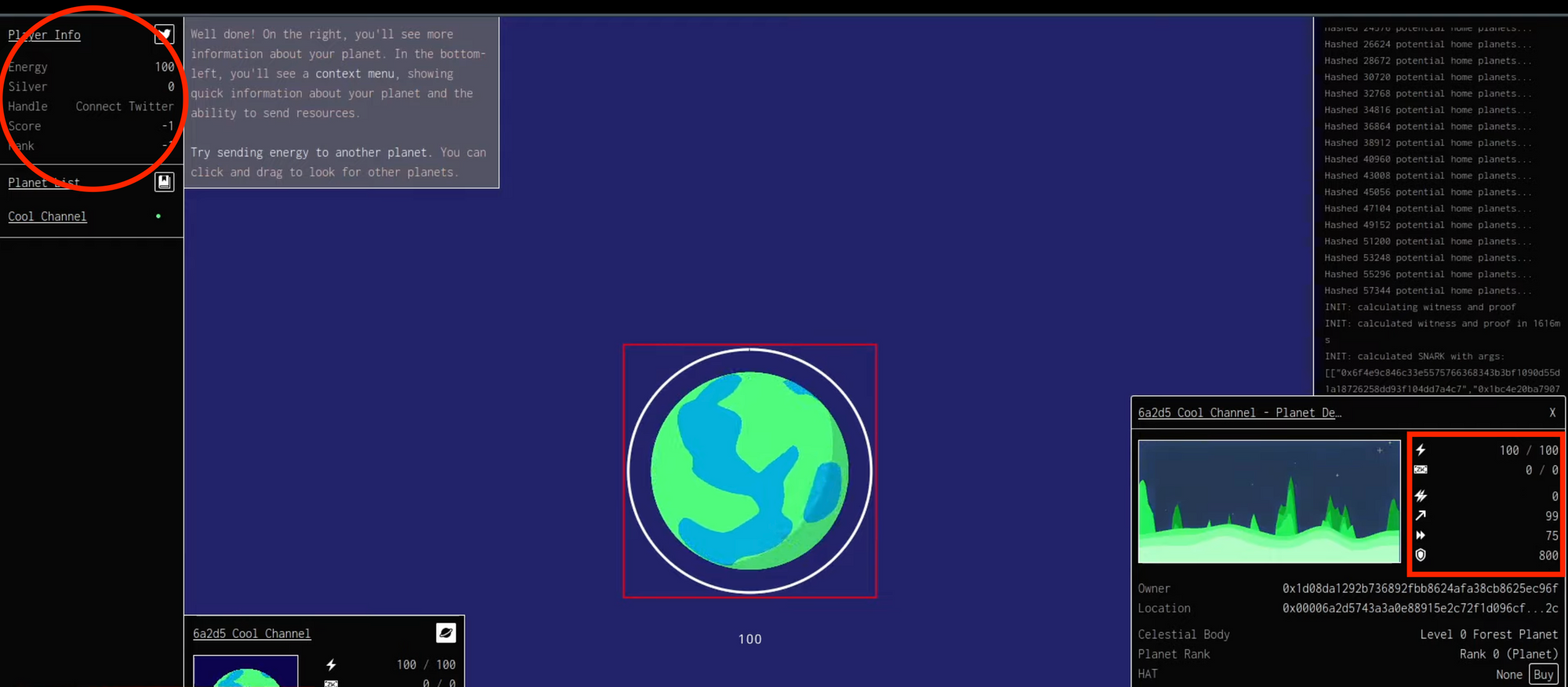
-
After logging in, players will be placed in a random planet.
The red box in the lower right corner shows the planet's attributes, as well as information on the planet type and owner.
The red circle in the upper left corner shows the player's current scores.
The Info Feeds on the right side display the actions and transactions history, and shows whether an action has been successfully on-chain.
By zooming out the view, players can see a grey war fog beyond the blue range and the cursor exploring one grid at a time.
From here, the game begins. Players can click and drag the mouse from their planet to the target planet to transmit energy in order to complete their first conquer.
3.3.3 Typical Game Process
Dark Forest is a highly customizable and immersive MMO strategy game with unique game mechanisms that change slightly in each round. As a result, players are encouraged to use their creativity and develop in-game and out-of-game strategies. (Yes, you can even engage in deceptions and betrayals within different communities to win LOL)
Typically, the earliest stage of the game is the resource accumulation period. During this phase, players will install their preferred plugins, and start to expand their vision to find suitable planets in the black area of Deep Space outside the blue Nebula Area to establish early strongholds. The focus then shifts to constantly consolidating their empire while starting to search for artifacts to increase strength.
Once an early foundation is established, players can carry out different tactical deployments according to their own style. Whether you are an explorer seeking the vastness of the universe, an artifact merchant looking to make a profit, or an aggressive player advocating for war, there is ample room to display your skills.
Here is a recommended article by MarrowDAO member @xiangcai.eth on "Personal Strategies in Dark Forest", which is a great reference for new players.
If you want to learn more about larger-scale wars, you can watch this recording by spencecoin, which was an epic universe battle between two top players, Ner0nzz (ranked second in v0.6.1) and 0x000da (ranked 7th in v0.6.2), held under privately agreed rules. Ner0nzz also explained the whole play from his perspective in an article.
3.4 Why Dark Forest stands out
In the previous section, we briefly introduced the definition of fully on-chain games and the Dark Forest. But why is Dark Forest such a significant name in the field without any advanced rendering technology or high-quality graphic performance? It is essential to understand what Dark Forest has accomplished in order to answer this question:
3.4.1 Technical level: FOC + zk-SNARK
- Fully On-Chain, FOC
Until Dark Forest, the feasibility of full-chain games had always been a conceptual hypothesis. This is because games are different from other applications, particularly for the implementation of real-time online multiplayer games that have high sensitivity to network latency and high-frequency interactions.
For example, MMORPG or MOBA games may involve more than 10 actions per second for a single player, and each of these actions requires real-time feedback to push the game forward, and unlike usual applications that only interact with the system, these interaction objects also include other players who are also interacting. which is almost impossible for the Ethereum which only has an average of 12-15 TPS.
Additionally, placing the entire game on chain implies that those interaction processes need to be deployed in the form of smart contracts, posing significant challenges for game selection and gameplay design.
Dark Forest is the first project to implement this conceptual idea, deploying all game rules and mechanisms in the form of contracts on chain, such that the state of players and the universe is updated on the chain in real time after any interaction. Even today, Dark Forest remains one of the most complex applications in the blockchain.
- zk-SNARK implements incomplete information game
In games, they can be divided into complete information games and incomplete information games, depending on how much information can be known by each other. The most typical case of complete information games is chess, where the board is open to all participants, providing a common information base for decision-making. In contrast, Texas Hold'em is an example of an incomplete information game, where addition to the five cards on the table, each player has two hole cards, which increases the challenge of decision-making.
In online gaming, the most common element of incomplete information games is the "fog of war", which creates an asymmetry of information by limiting players' views. However, this method was practically unworkable in the previous blockchain environment, as once an action is posted on chain, the details would be open to the public, making the fog of war become meaningless.
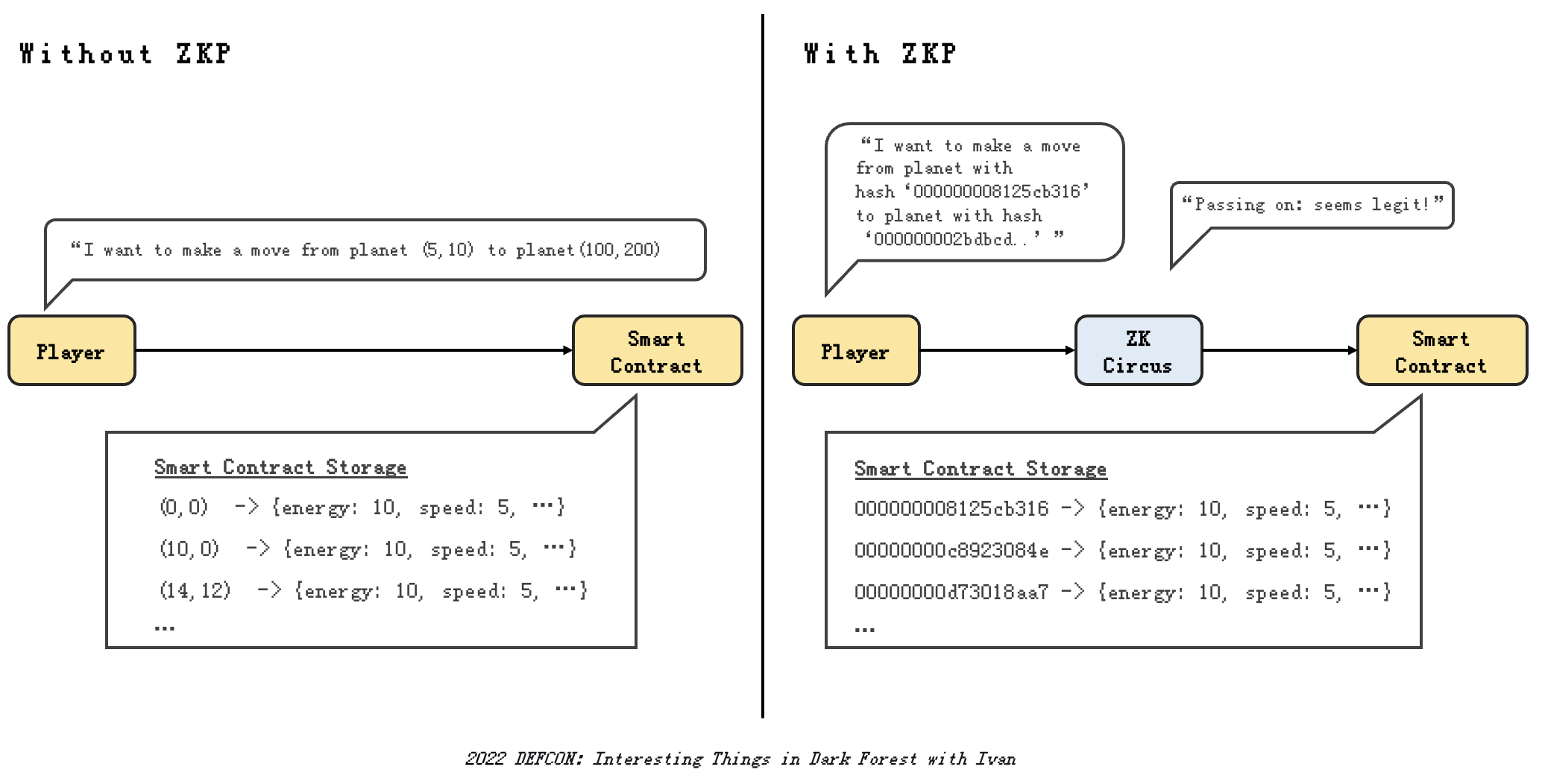
Yet, Dark Forest has implemented the zkSNARK algorithm, achieving the concealment of player interaction information and making incomplete information games feasible on the blockchain. This has enriched the application scenarios of zk technology and the possibility of fully on-chain gaming.
3.4.2 Experience level: A crypto primitive game with high composability and a wide-open ecosystem
The scheme of fully on-chain and open-source, endows Dark Forest with an essential characteristic, which is "Permissionless Interoperability".
Fundamentally, Dark Forest are smart contracts, akin to a protocol or rules. This means that it is no longer limited by a particular client, as it is Client Agnostic. Any people can create a front-end client with their preferred visual format to invoke the contract's parameters or functions. Furthermore, any address can also interact with it, whether it is a person, a bot, or another smart contract, which expanded the boundaries of gaming strategies and spawned a thriving plugin ecosystem.
In this ecosystem, players spontaneously combine, construct, and try out various things and gameplay, forming an organic community. Things created in the process have gone far beyond the initial expectations and brought lots of surprises, such as artifact trading markets, planet bounty systems, and even war AI.
The emergence of these plugins adds extra game purposes and strategies, allowing more types of players to join. The introduction of the Lobby system and the development of the on-chain engine even gave way to rule releases by players themselves.
This open high-combinatorial attribute has expanded gaming possibilities, allowing players to participate in the gaming experience's construction rather than relying solely on the official team.
3.5 The Ecosystems inside Dark Forest
As mentioned in the previous section, the ecosystem is one of the most important parts of the Dark Forest. In fact, after the deployment of core rules/contracts, the official team doesn't have much involvement, as they position themselves as scientists in a laboratory, setting up a growth environment for the culture and patiently waiting for its free and wild evolution. Here, we are going to provide a brief overview of some of the notable communities and plugins inside the ecosystem.
To gain a comprehensive understanding, it is highly recommended to participate in the entire ecosystem and gain personal experience.
3.5.1 Community Ecosystem
-
Dark Forest: First and foremost is the official community of Dark Forest, which serves as the petri dish of the ecosystem. There is less operational behaviour except for specific activities or announcements and daily problem-solving.
-
Project Sophon: An American team(not a DAO) that firmly supports Dark Forest's vision and collaborates closely with the core team. Project Sophon has a strong technical background, focusing on infrastructure-level development. They have developed a Dark Forest local library that allows users to start a game offline or online.
-
Orden_GG: A hardcore Ukrainian gaming organization that has a high level of expertise in both coding and gaming. They achieved 4 consecutive victories in v0.6, and are excellent builders within the ecosystem. They developed the "Artifact Marketplace" with a liquidity pool. They are also a core player of Aavegotichi and have even created an open-source client for it.
-
D_F DAO: It is a DAO mainly composed of Americans and was established in v0.6. They are a group of people who put more focus on innovative gaming experiences. They have created many interesting things in the Dark Forest, including the "The Astral Colossus" (a smart contract that allows members to gift their empire to the contract in a collective form to win) and the "Dark Forest Arena", a MOBA-style DF game, among others. They are skilled at organizing and trying new strategies within the game. Overall, they have excellent branding and operations and is a very active community within the ecosystem.
-
MarrowDAO|GuildW: It is a DAO that is very active in expanding and promoting the Dark Forest especially. They are a core evangelist for Dark Forest, especially within the Chinese communities. MarrowDAO produces a lot of high-quality articles and strategy sharing and also has developed several plugins, including "Artifact Marketplace" and "GPU Mapping Mining Tool". They are also the first organization to hold a community round, which requires the community to manually modify the client and contracts since there was no Lobby system at the time, and that is definitely a remarkable achievement.
-
277DAO: It is a community that focuses on blockchain gaming. They are good at organizing events and have hosted 5 Dark Forest community rounds right after the Lobby system was launched. They are also one of the major evangelist in the Chinese community, having translated and written many Dark Forest-related tutorials and articles, and developed some interesting plugins.
-
DF Archon: is a small group of developers dedicated to fully on-chain games. In the Dark Forest, they have developed and integrated multiple plugins, they packaged the DF tools’ functions into DF-Gaia, a more user-friendly one for both developers and players to use. They also created the first planet bounty system DF-ARTEMIS.
-
P DAO: A relatively mysterious small-scale Chinese group that appeared in version v0.6.5. Unlike large-scale DAOs with extensive plugin usage and group expansion strategies, P DAO focuses more on efficient collaboration among team members. Through the strategy of full round voice chat and shift work, they achieved excellent results, with 7 members occupying the top 10 spots in version v0.6.5.
3.5.2 Plugin Ecosystem
Plugins are a crucial component of Dark Forest, and currently the official plugin library contains 55 open-source plugins. Here, we will only briefly introduce few of them here.
Plugins can be generally divided into 3 categories based on their purpose:
-
Visualization: Dark Forest has a relatively simple game interface, so many plugins have emerged to present better UI and more information. Some commonly used ones include:
-
Data visualization: Heat Map, Mini Map, Voyage Time, Map Filter Export by @DF Archon, etc.
-
Highlight or mark specific targets: Highlight Buffs, two helpful plugins for teaming up by @DF Archon - Peace Dove and Highlight Friends, etc.
-

-
Marketplace: The marketplace allows players to exchange different resources and adds new game motivations for players, including:
-
Artifact trading market: D_F DAO's Artifact Market, Marrow DAO's Dark Sea
-
Coordinate bounty market: NightMarket, which is based on zkp by @0xSage and @xyz_pierre, and Project Sophon's Broadcast Market
-
Planet bounty market: Artemis by @DF Archon
-
-
Automation: This type of plugin is used more frequently, it helps players to simplify those complex and tedious actions to improve efficiency through scripts. They include:
-
Resource-related: Artifact capture and management set - Hunt Artifacts & Artifactory, Distribute Silver, Centralize Resources, etc.
-
Combat-related: Crawl Planets, Repeat Attack, Simultaneous Attack, and even Wage War that can automatically declare war against players, etc.
-

Besides these 55 plugins, there are also a large number of plugins developed by players or communities outside the official system but circulating inside the ecosystem, which created rich game experiences and diverse gameplay. Community players have even developed an AI that can play Dark Forest.
Such open community, in which players could initiatively construct game experiences and compose tools around the core universal rules, allows Dark Forest to have broader possibilities than traditional centralized games.
4. The Peerless Twins: Loot
Loot is unlike Dark Forest, which has a well-defined gaming objective and mechanism; it is an NFT project without any established rules from its outset, relying solely on 8 lines of text on a black background to make a wave throughout the entire crypto community. But perhaps even now, many participants are still puzzled by what Loot really is.
4.1 Origin
Loot (for Adventurers) is an experimental project launched by Dom Hofmann on August 28th, 2021, following his previous experimental project "Blitmaps". He is also a member of the founding team of the well-known CC0 project "Nouns". Prior to this, he was the founder of the once-popular video-sharing app Vine, which was later acquired by Twitter. Currently, his new project, "SUP", has received $12 million seed round investment from Paradigm.
The concept of Loot was first announced by Dom on Twitter on August 25th, 2021. On the 28th, the contract was officially deployed, and a total of 8,000 Freemints were released, of which 7,777 were publicly available for sale, and the remaining 233 were reserved by Dom. Less than three hours after the project was announced, all 7,777 NFTs were minted.
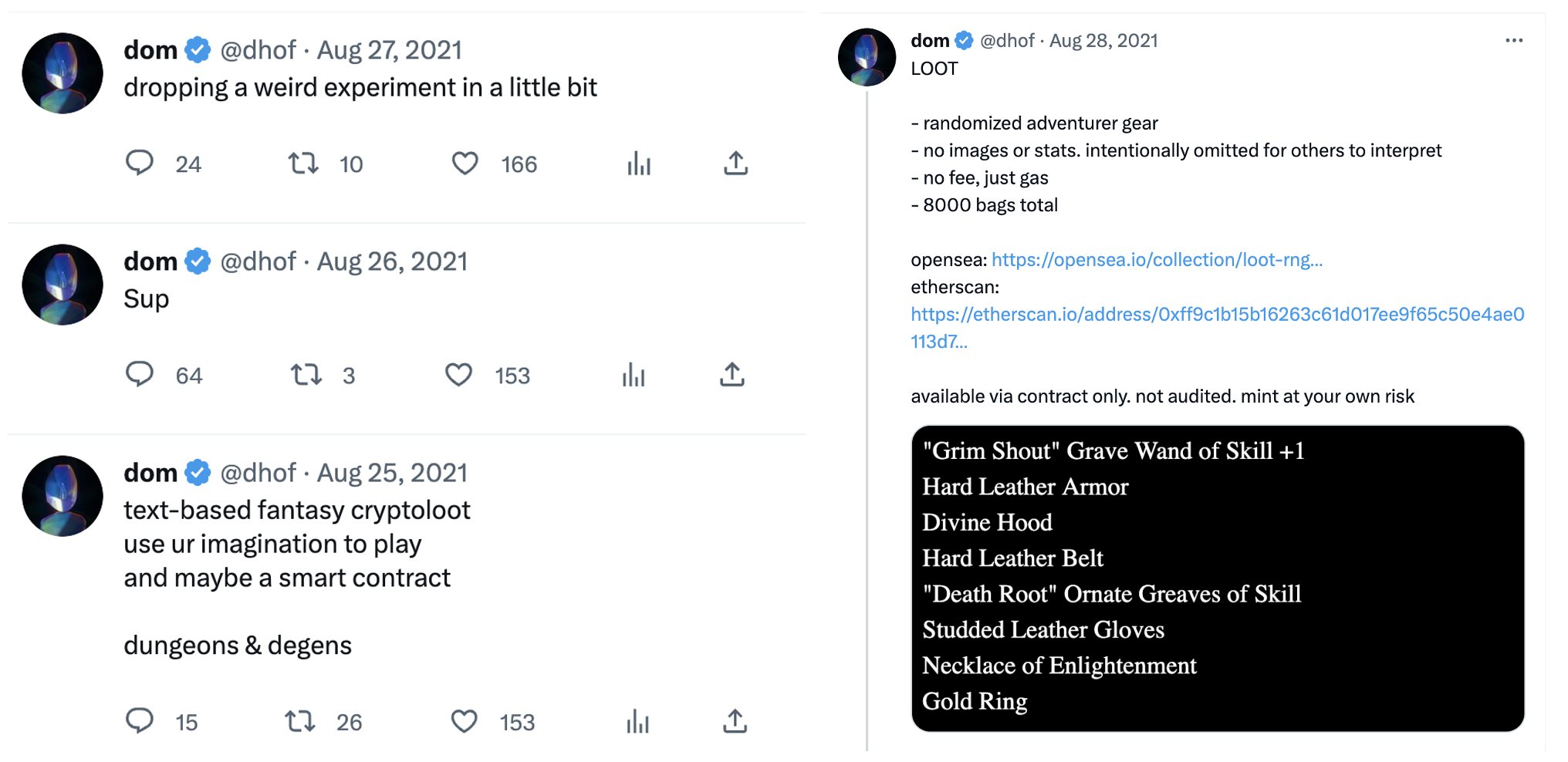
4.2 Philosophy
What sets Loot apart from mainstream NFT projects is its bottom-up approach.
In traditional NFT projects, we purchase a complete art piece or IP from the project team/creator and expect the project team/creator to build more content around the theme/IP's universe. This creator-driven approach places the core value and equity of the project in the hands of the creators, while the community and holders are relegated to a more passive role of receiving or creating peripheral content. This is referred to as a "top-down" approach. This approach often heavily depends on the key roles to push the project forward, any absence of these roles will cause significant obstacles to the project's development.

However, from the success of projects like BAYC and Azuki, we can see that the cohesion and creativity demonstrated by community members have played an indelible role in propelling these projects to success. Loot aims to inspire and unleash this unparalleled potential to create a fully decentralized project defined by the community.
Loot did not try to become an IP, it is just 8 lines of white text, with no images or colors. The charm of the text lies in its different interpretations in everyone's mind. Each person can use these texts to construct the world they understand.
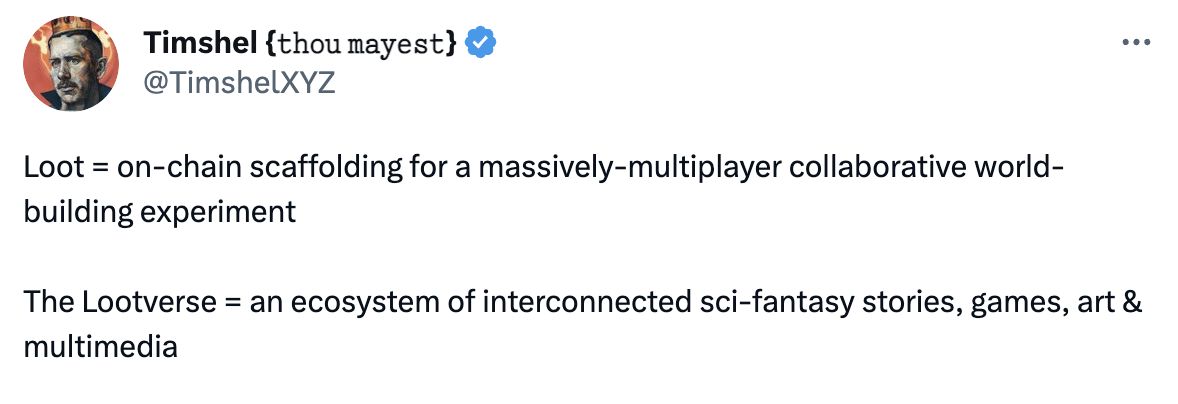
After the project was launched, founder Dom almost never involved himself in any of its affairs. This behaviour of not restricting any development and completely entrusting governance to the holders also achieved true openness. As Vitalik stated:
"Pretty much anything that anyone creates "exists", what matters is to what extent other people build upon it"
But also, there are very apparent advantages and weaknesses in this approach. Loot is like a pile of bricks that people can use to build various buildings, which might be large and magnificent, or exquisite and ingenious. It takes down the roof of NFT, and blockchain technology also endows it with the feature of composability, which any other project can quickly gain a large amount of traffic and content by introducing Loot or integrate it with other Loot projects.
However, if no one comes to build, discuss, or try things out, then it will just become meaningless, not even a 'jpg'. Also, just as Rome was not built in a day, early construction and accumulation of the ecosystem also require a period of time to go through.

Fortunately, as the current situation shows, Loot is steadily accumulating and has gained recognition from many excellent developers and crypto natives. Dozens of naturally formed teams are continuously making positive contributions to the community, creating an open and organic ecosystem.
4.3 Loot Overview
4.3.1 Secondary Market
The initial trading price of Loot was merely 0.05 ETH, which did not garner much attention in the NFT Summer. The price remained stable at around 0.1 ETH for the next two days.
However, no one could have foreseen the insane surge of Loot, which began on August 30th. The price skyrocketed and reached its historical peak on September 3rd, with an average price of 18.5 ETH, and the highest floor price on that day reached 20 ETH. But the market cools down very soon as speculative took their profit, and only a few could really understand the potential and philosophy of Loot's ecosystem. The price fell to around 2 ETH by the end of 2021.
With the arrival of the bear market in 2022, the price of Loot continued to decline, maintaining around 1 ETH before October 2022 and falling below 1 ETH after October.
Currently, the price of Loot lingers around 0.7 ETH, with 2,520 holders and 140k+ ETH total trading volume. The total market cap of Loot is about 82k+ ETH, ranking 16th in the market, but the daily trading volume remains relatively small.

4.3.2 Loot Core Series
- Loot (for Adventures)
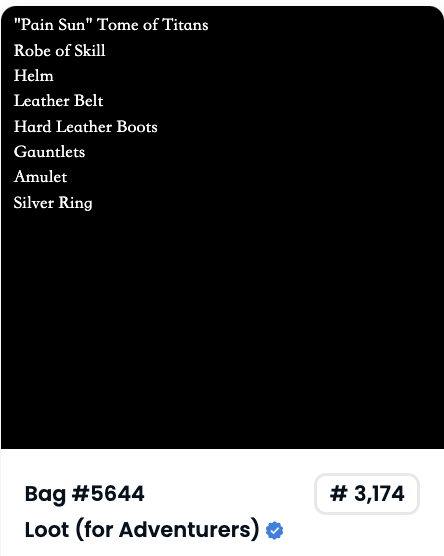
-
Loot, also known as OG Loot, was launched on August 25, 2021, with a total of 8,000, of which 7,779 are currently in circulation in the market. Each NFT represents a loot bag containing 8 pieces of equipment, with each line of text describing the corresponding equipment: weapons, chest armor, head armor, waist armor, foot armor, hand armor, necklaces, and rings. However, the ultimate interpretation of the textual description is completely open, anyone can present the visualization or even the meaning of the description in their own way.
-
Synthetic Loot
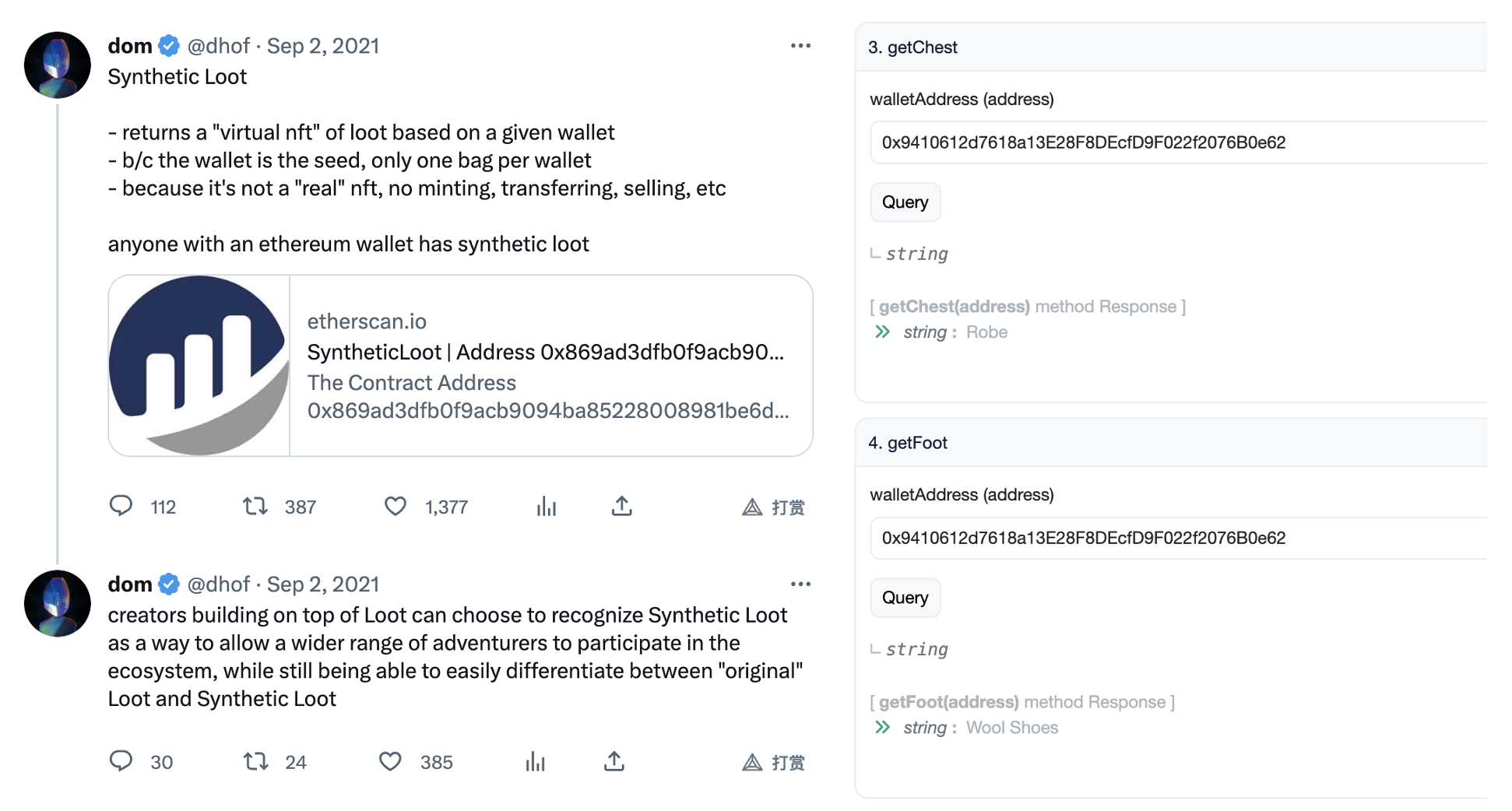
-
Synthetic Loot is not an NFT, but more like an algorithm introduced by Dom on September 2, 202. It basically converts wallet addresses into random Loot identities, allowing more people to participate in Loot. Any address can obtain one and only one set of Loot-like output through this contract, which is very similar to the concept of SBT in the Loot version. Any developer can call this contract to achieve connection or integration with Loot.
-
More Loot (aka. mLoot)
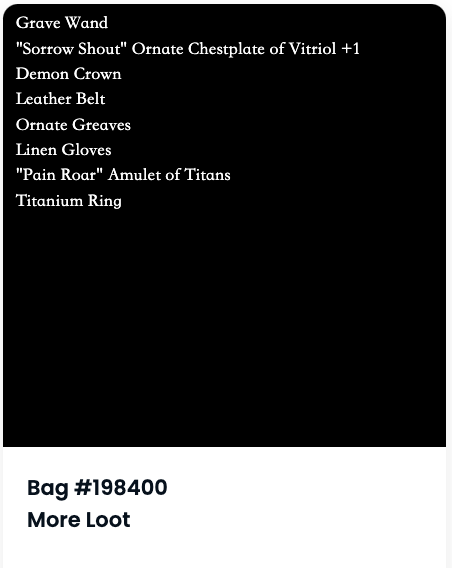
-
More Loot, a derivative series, was released by Dom on September 4, 2022. Starting from ID 8001, it dynamically generates approximately 250,000 items per year at 1/10 of the Ethereum block speed, with a total supply of around 1.5 million, and has currently minted 135,335. Users can choose the ID they want to mint, and apart from their IDs, all the other properties are just the same as the OG Loot.
-
Genesis Adventures (for Loot)
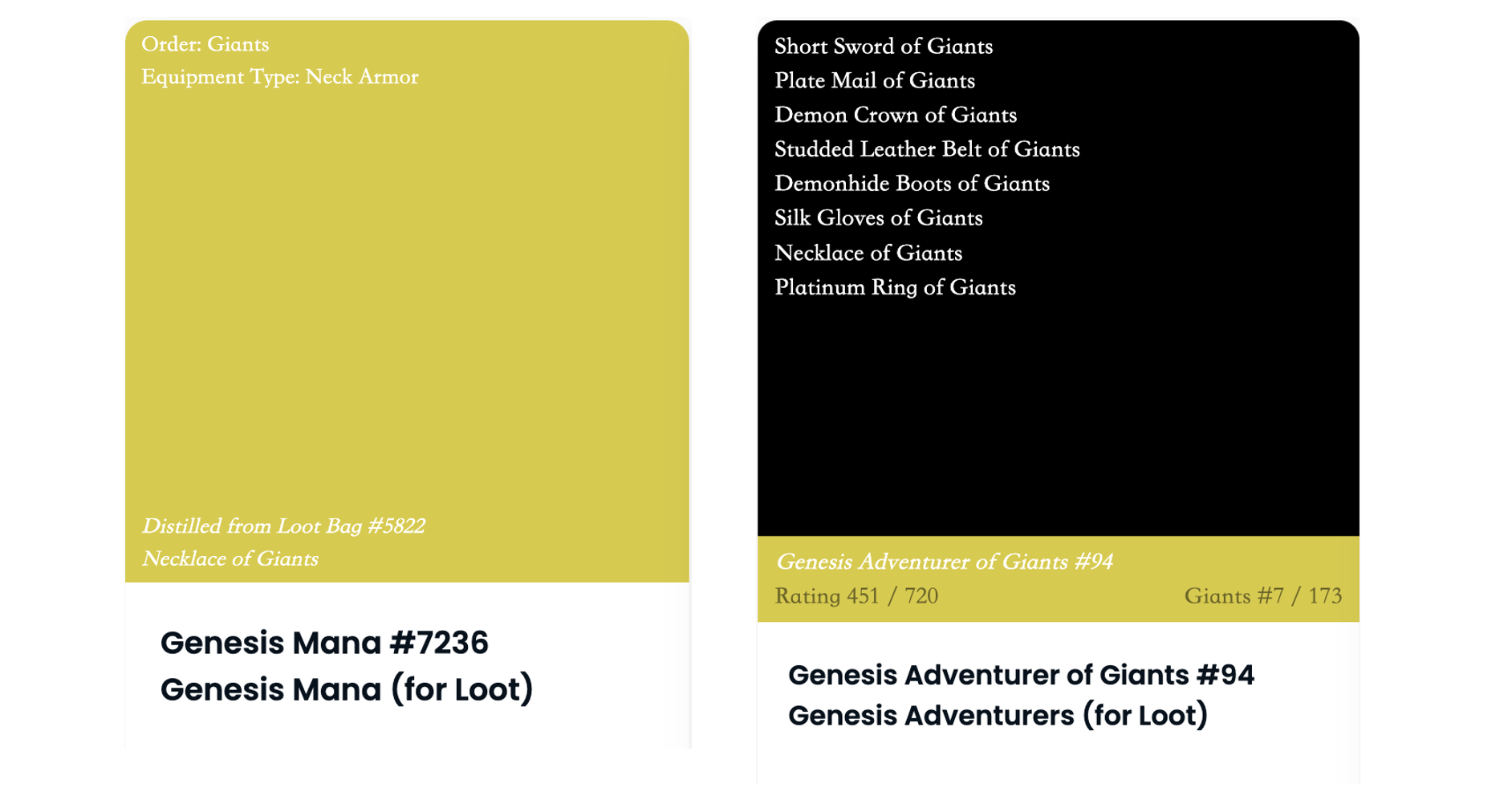
-
Genesis Adventures is a crucial product of the Genesis Project launched by the core community member of Loot, @Timshel. It is also the first derivative series in the Loot ecosystem that has developed from a narrative perspective. It attempts to interpret the origin of Loot through the analysis of the suffixes from Loot's attributes and extracts the concept of "16 Orders" (a concept similar to factions or clans).
Loot holders can extract the intermediate product "Genesis Mana" NFT by Distill Loot with suffixes. By collecting 8 Mana of the same Order, people can summon the corresponding "Genesis Adventure". The theoretical maximum limit is 2540, and currently, only 628 have been summoned.
This is a very interesting process that involves a lot of cooperation between community members and ecosystem organizations, including timeline writing in collaboration with DivineDAO, issuance of the $ATIME token, and so on. It has gained widespread recognition within the ecosystem and becoming one of the advanced identities in the Loot universe through its narrative. Furthermore, through the Scroll project, it could even give certain NFT a story and an exclusive name, forming an interesting connection like Jon Snow (GA) and normal soldiers (Loot) in the Game of Thrones. It is no doubt an extremely unique project.
4.3.3 Token-related Information
As an open-source project, Loot has not released any official tokens. All the tokens related to the Loot ecosystem are issued by the communities and projects inside the Loot ecosystem. Currently, the two highest market value tokens are $AGLD issued by Will Paper and $LORD issued by Loot Realms ecosystem:
-
Adventure Gold ($AGLD)
The earliest Loot ecosystem token which released by Will Paper on September 2, 2021, with a total supply of 77.26 million. The holder of each Loot can receive a 10,000 token airdrops, and its highest price reached $7/AGLD on the first day of trading.
Currently, $AGLD hovers around $0.5 with an FDV of $36.33 million and a circulating market value of $31.97 million.
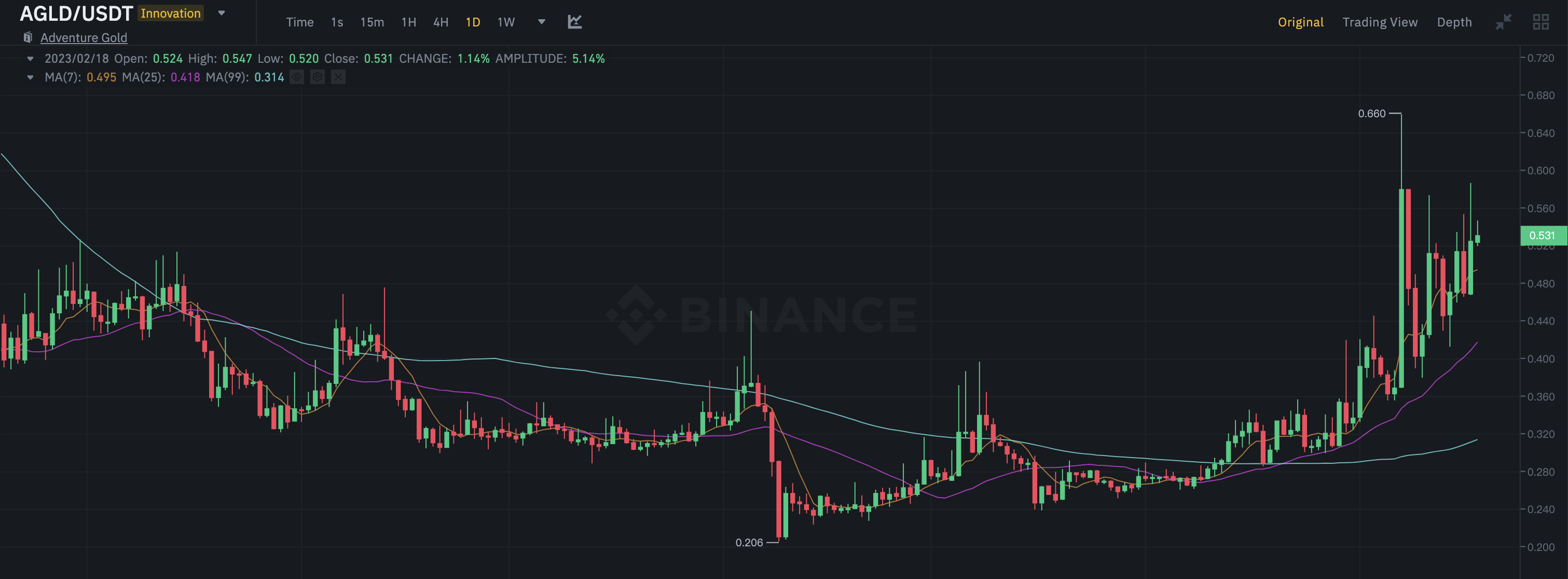
-
Lords ($LORD)
It is an ecosystem token released in December 2021 by BibliothecaDAO, a vital community inside the ecosystem and the founding team of the derivative project Loot Realms. The token has a total supply of 500 million, of which 89.65 million have been issued.
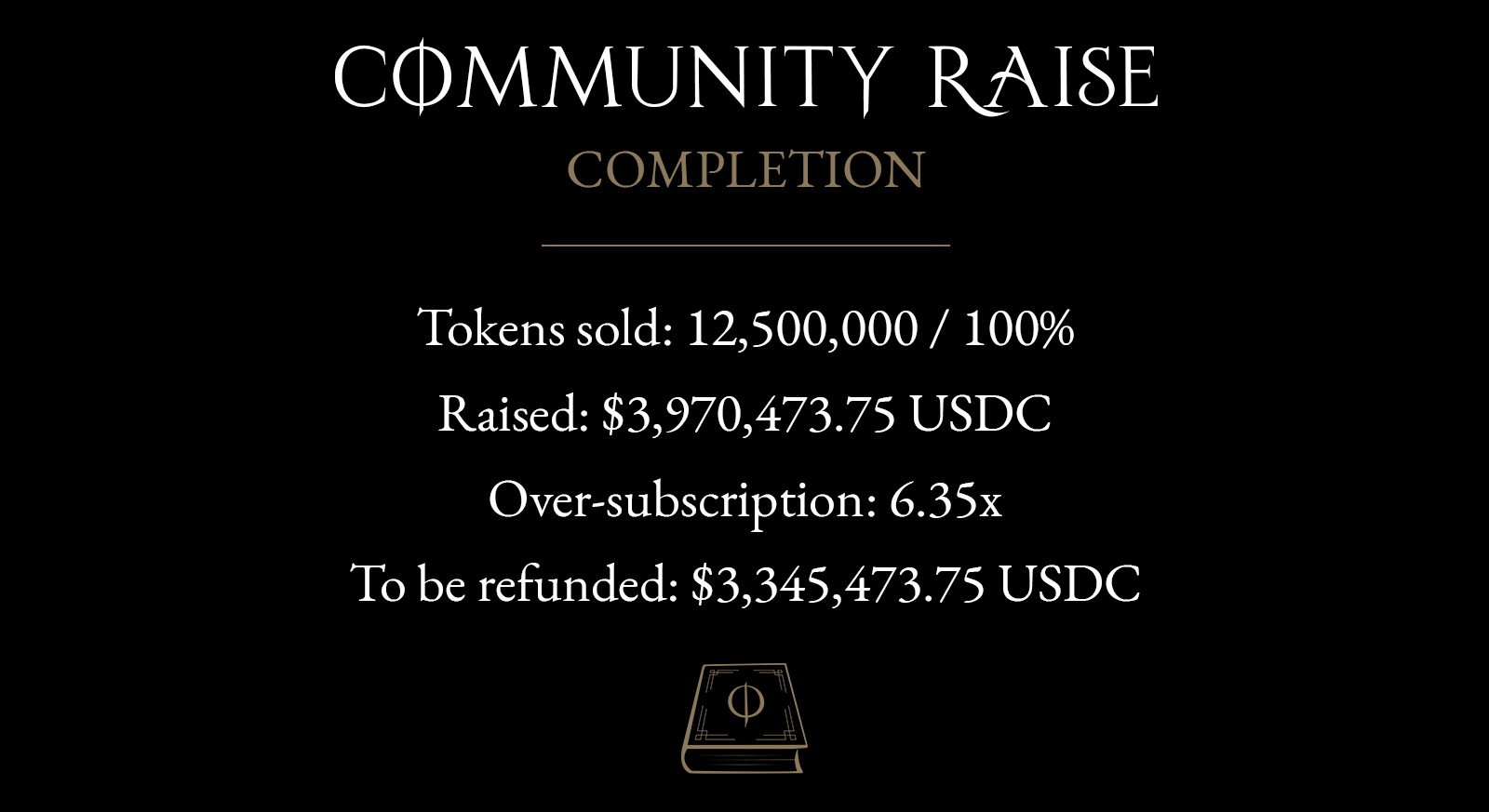
-
On February 1, 2023, the community completed the execution of the 7th governance proposal (BIP-7), selling 12.5 million $LORD at a price of $0.05, with a target fundraising of $625,000. However, this private round only the community members, which ultimately raised $3.97 million, over-subscription by 6.35 times. After the refund, the secondary market price of $LORD also pumped from $0.09 to a high of $0.169.
Currently, the price of $LORD is fluctuating around $0.13, with an FDV of $12.22 million and a circulating market value of $6.94 million.
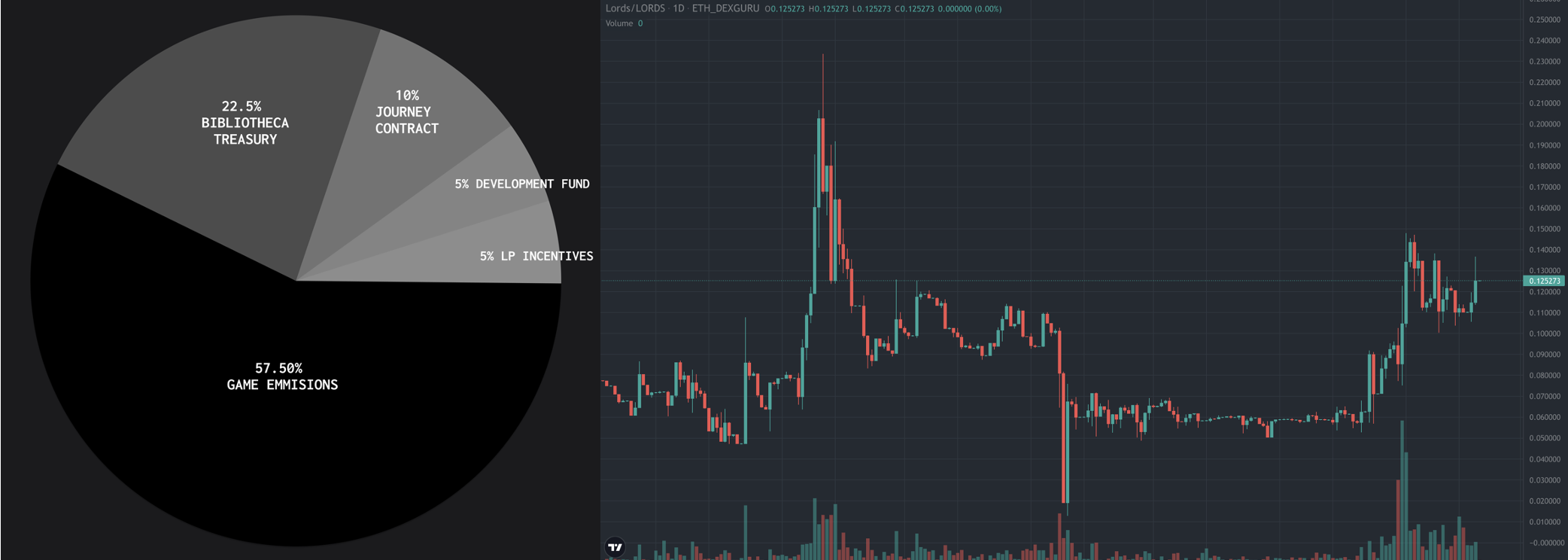
4.4 Narrative and Ecosystem of Loot
As the founder of Loot, Dom opted to take a mostly hands-off approach to the development of the project, instead allowing it to grow organically. Throughout this process, many exceptional contributors and community organizations gradually emerged, particularly Timshel @TimsheXYZl and Loaf @lordOfAFew, who, through their sustained positive contributions to the community, have become key figures and even spiritual leaders within the Loot ecosystem, leading the community forward. Currently, Timshel focuses more on the macro-narrative development of the Loot universe, while Loaf primarily assists in the implementation of Loot's related projects.
4.4.1 Narrative: Loot.Foundation
Firstly, it must be reiterated that there is no official authority or mandate for Loot, and therefore, obtaining recognition and consensus from other community members is truly crucial. This requires sustained contributions and the creation of high-quality output.
In the process of expanding the narrative, Timshel has undoubtedly played a crucial role. The Loot.Foundation he initiated is now the cornerstone for community contributors, and the Loot universe he has interpreted through early in-depth exploration of its properties and contracts has become the mainstream narrative today.
In this narrative, "Cycle after Cycle" is the foundation of the world. Loot bags are some kind of artifacts left by the ancestors, accidentally discovered and excavated by later generations. Through continuous learning and understanding of the bags, new inspirations are gained, and new creations are made to explore further boundaries, all while making the Loot in hand stronger. This intergenerational process has come to the third cycle, the era in which "we" find ourselves, where the cycle repeats once again.
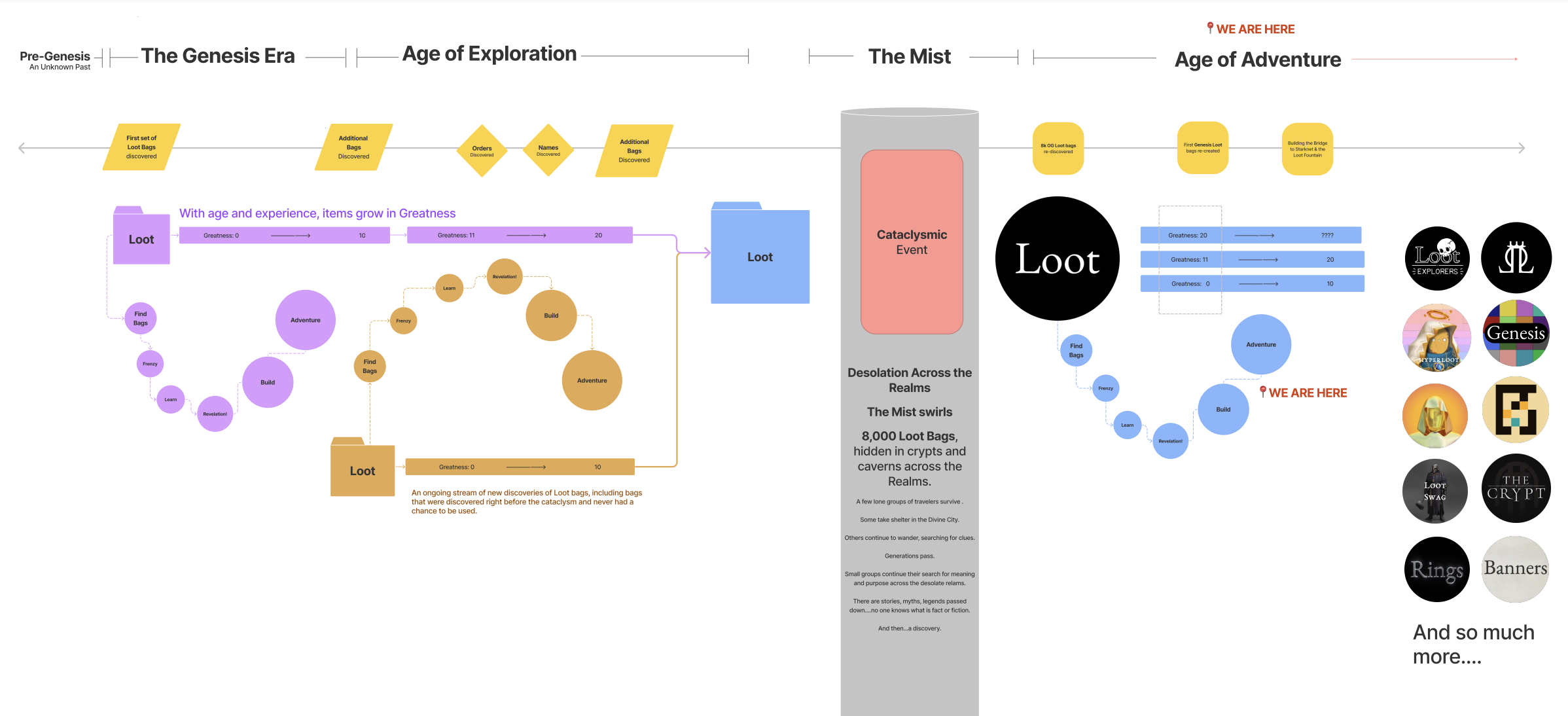
On the Loot.Foundation website, there are only rough outlines provided for each period, and the historical stories and events are left blank for anyone to fill in and expand upon.
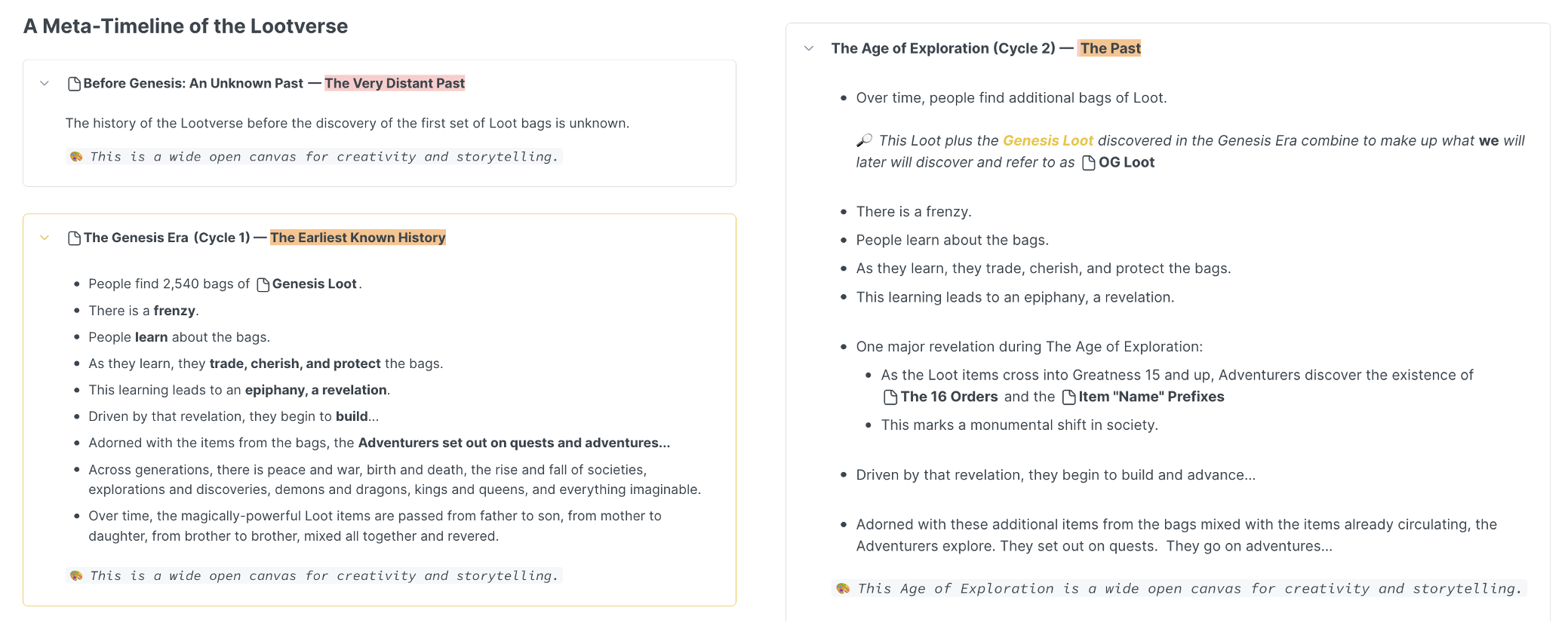
To advance the development of this content, Timshel has even launched a new project, Open Quil, dedicated to collecting and selecting high-quality content. Genesis Scroll is a content expansion project for the first period, "The Genesis Era."
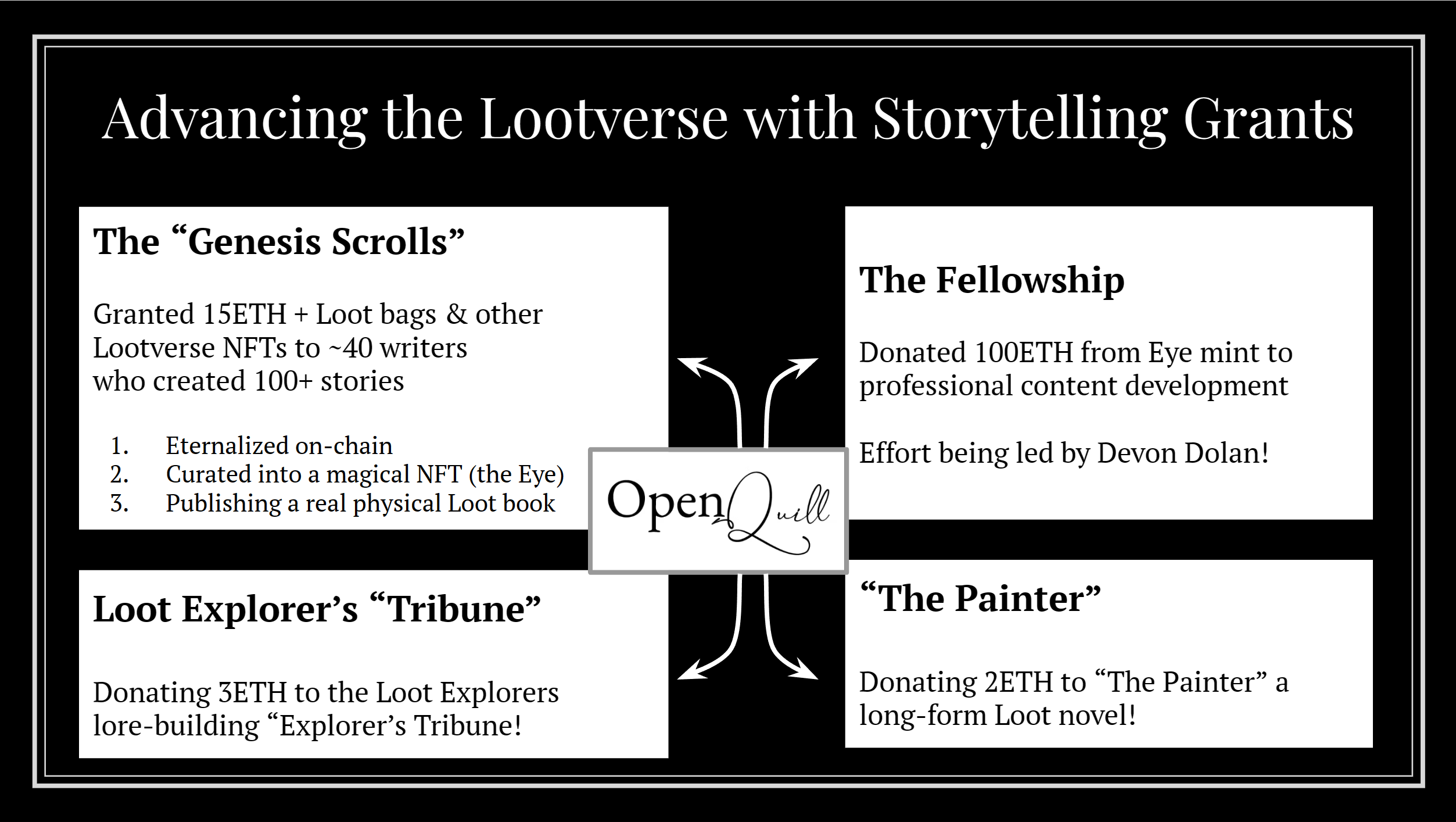
The Genesis Scroll was initially launched on Loot's community forum, Loot-talk, and later continued on the openquil platform. It is an open narrative collaboration project for everyone to freely imagine and create content about characters, families, wars, poems, and more in the Genesis Era.

If Loot were to be compared to "Game of Thrones," Genesis Adventures would be the major characters who left their names in history, while Genesis Scroll would be the storybook of their or their family. There may be different chapters, just as "The Biography of Jaime Lannister" in "Lannister Family" and Loot could have "Genesis Scrolls · The Fox · Raeven."
Currently, Genesis Scrolls has successfully completed three rounds of Writing Grants, with main sponsors including Loot Community, Genesis Community, Realms Community, and other Loot ecosystem projects. Meanwhile, Mask Network, as a core supporter of decentralized philosophy, has also provided $10,000 grant. Scrolls have accumulated more than 100,000 words of rich content already.
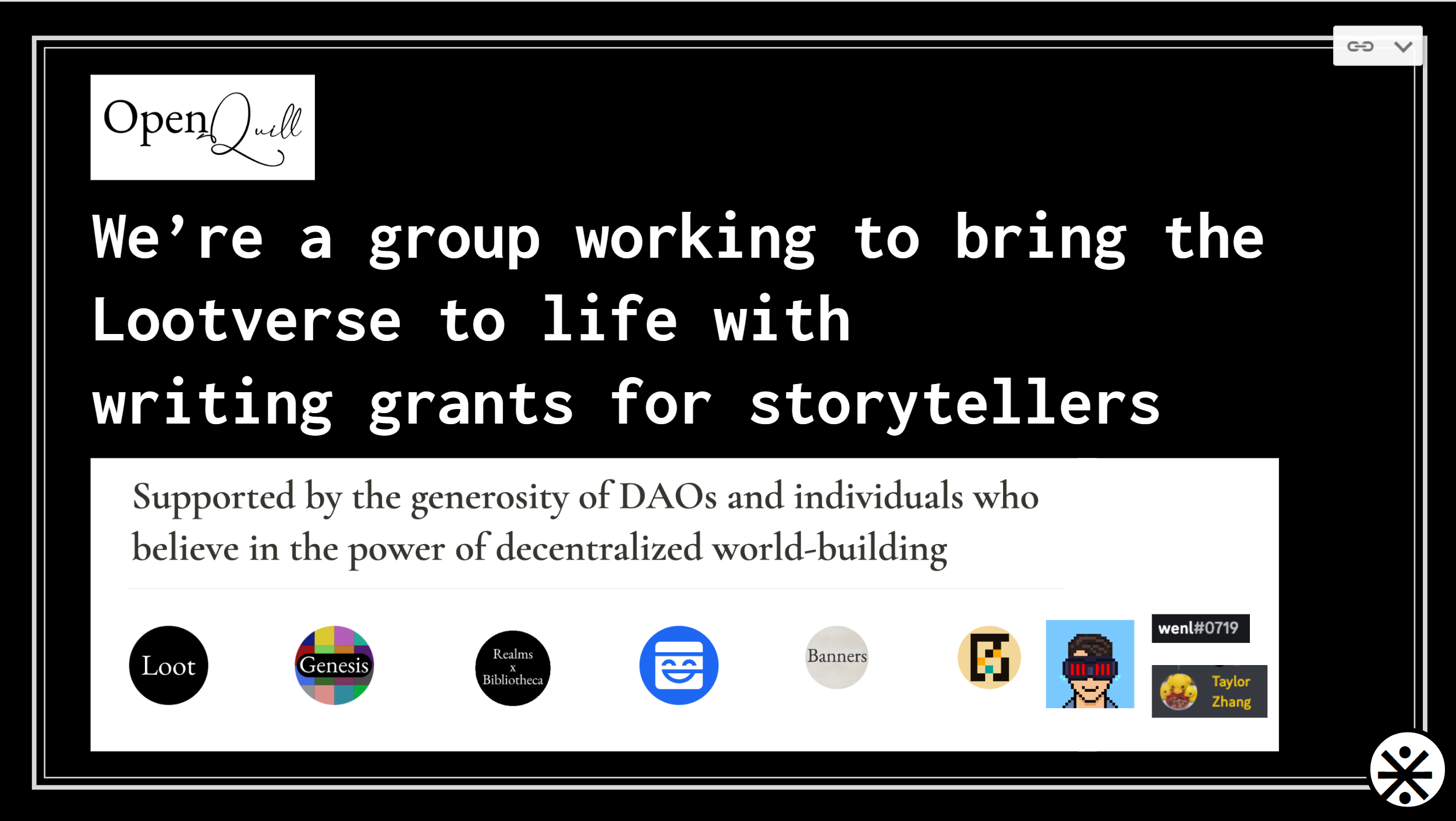
However, this does not mean that Loot Foundation's interpretation will be the only version. One of the most interesting features of Loot is its open narrative ecosystem. Essentially, Loot does not provide any substantive elements but more clues to the elements, and the interpretation of the clues can ultimately have countless versions. The simplest analogy here is various poker games. No matter how strange the rules are, as long as people are willing to participate, the rules are established.
Therefore, even if a completely new Loot narrative version with an eastern fantasy style is emerging in the future, it is not impossible for it to gather recognition from other participants. After all, the greatest significance of "meaning" is being believed.
4.4.2 Loot Ecosystem
Loot's wide inclusiveness initially attracted numerous derivative projects, although many failed to achieve sustained development, they collectively constructed a vast Lootverse. Detailed information about the projects within the ecosystem can be found on the Loot website's Resources and Loot Watcher. This section will only provide a brief introduction.
After a relatively long period of time, the projects and organizations that continue to persist in the Loot ecosystem have relatively good development or content production capabilities and deep faith in Loot's philosophy. Some of the relatively active projects/organizations in the current Loot ecosystem include:
-
Loot Realms (Bibliotheca DAO)
Loot Realms is a land derivative project developed by Bibliotheca DAO. It was first launched on September 14, 2021, with a total supply of 8,000. Bibliotheca DAO is a decentralized open-source game studio focused on the StarkNet ecosystem with a clear roadmap.
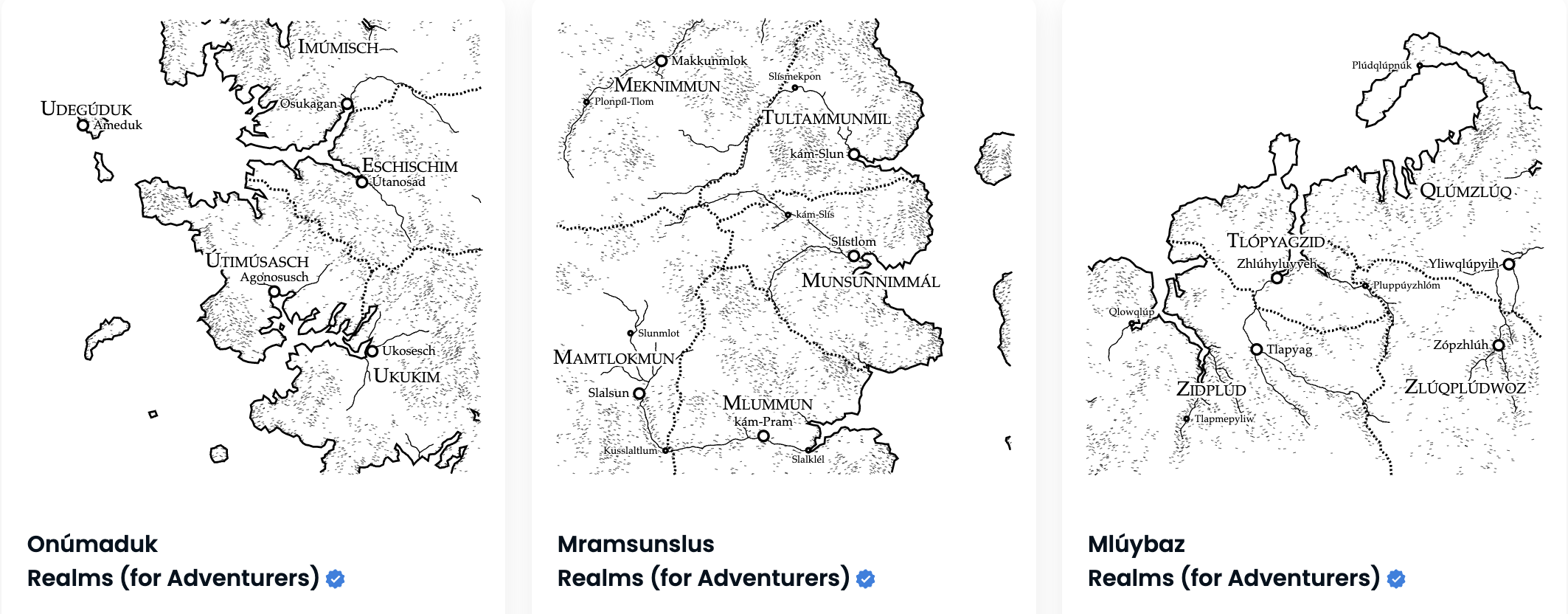
-
According to the current roadmap, 2 products will be developed based on Realms, and a private round of fundraising was conducted on January 31, 2023, which achieved 6.35x over-subscription. Currently, the fully on-chain game Realms: Eternum is launched its beta version on Starknet Testnet (see section 4.5 for more details).
-
Crypts & Caverns
Crypts & Caverns is also a Loot land derivative project, launched in November 2021 with a total supply of 9000. Unlike Realms' city-like territory, Caverns is developing towards small-scale maps. Each Crypts & Caverns is a randomly generated "seed-form" dungeon map that continues Loot's underlying "clue" concept. This means that any developer can call its contract to create its own front-end visualization and generate random dungeons. Hero.fun, for instance, created a game similar to Beacon using Crypts & Caverns metadata.
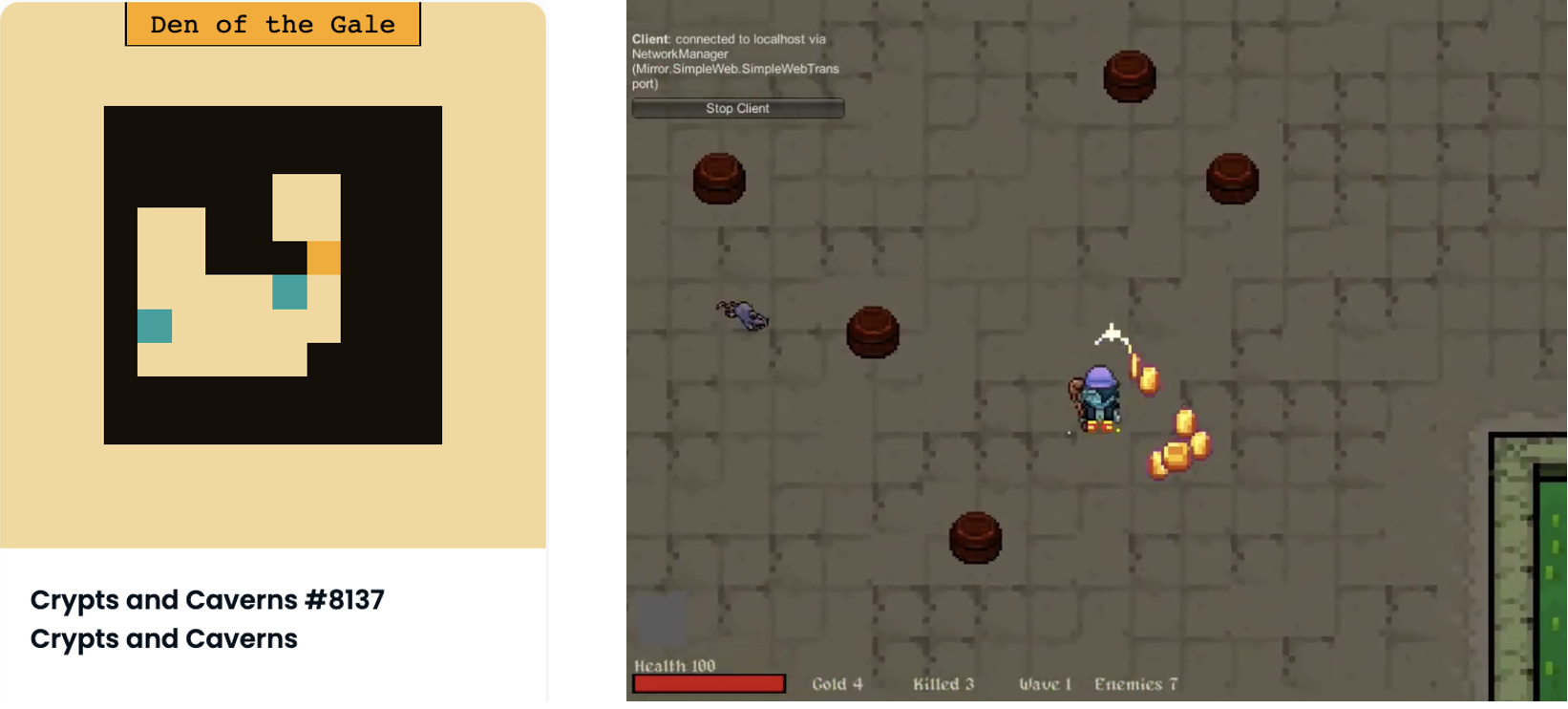
-
Currently, C&C is constantly exploring new ideas and actively collaborating with Realms. In the future, a very interesting model may emerge, such as Loot holders entering random C&C dungeons to battle in the Realms ecosystem. Winning the battle would allow them to take away the dungeon's spoils, while death would add experience to the dungeon, and the equipment on them would be eaten by the dungeon and returned to the corresponding C&C holder.
-
HyperLoot
HyperLoot, one of the high-quality visual projects among various Loot derivatives, was launched in April 2022. All Loot, mLoot, and GA holders can mint a corresponding HyperLootNFT for 0.05 E, with a total supply of 20,000, of which 8585 have already been minted.
Perhaps due to the fact that one of its co-founders is a senior art director with extensive experience in game character design, having participated in game projects such as Hearthstone, Clash of Clans, Clash Royale, and NetEase Harry Potter, HyperLoot has a higher acceptance of art style compared to other visualization projects, as well as a clearer roadmap and progress.
On February 10, 2023, they announced their latest progress, having already completed the 3D modelling of all HyperLoot NFTs. Soon, the original owners will be able to upgrade their NFTs to the 3D version. Additionally, the self-developed mobile game, "HyperLoot: CC0 Wars game," is also set to launch soon. From the revealed information, the art style is quite similar to Clash Royale and Brawl Stars, making it an on-chain asset-based MOBA mobile game.
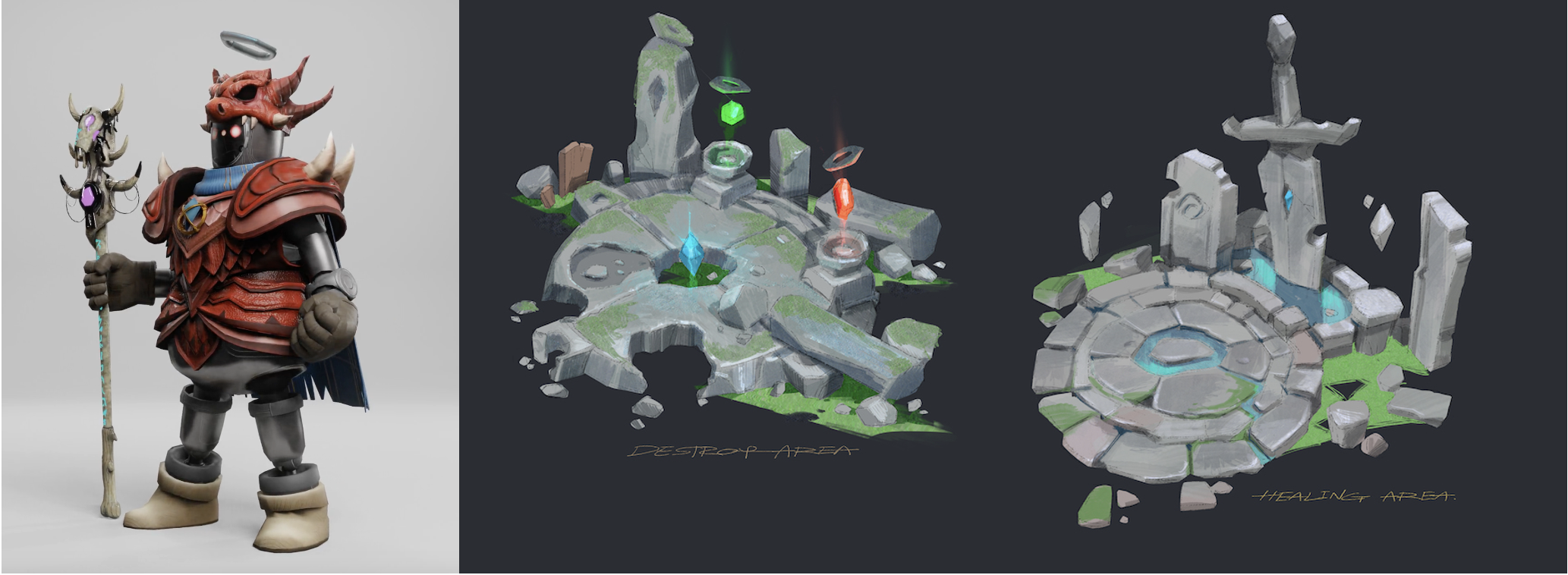
-
LootMMO
LootMMO is a Loot ecosystem MMORPG game based on the open-source game engine CORE (based on UE), and incorporates many projects within the Loot ecosystem. Although it has not yet achieved full on-chain implementation due to its open-source nature, it has attracted and encouraged many developers to participate in the construction of the game.
From the gameplay video on the official website, LootMMO already has a fairly impressive gameplay present, with a touch of World of Warcraft style. It is also highly anticipated that it will present a fantastic game experience in the future as the Loot universe narrative expands.
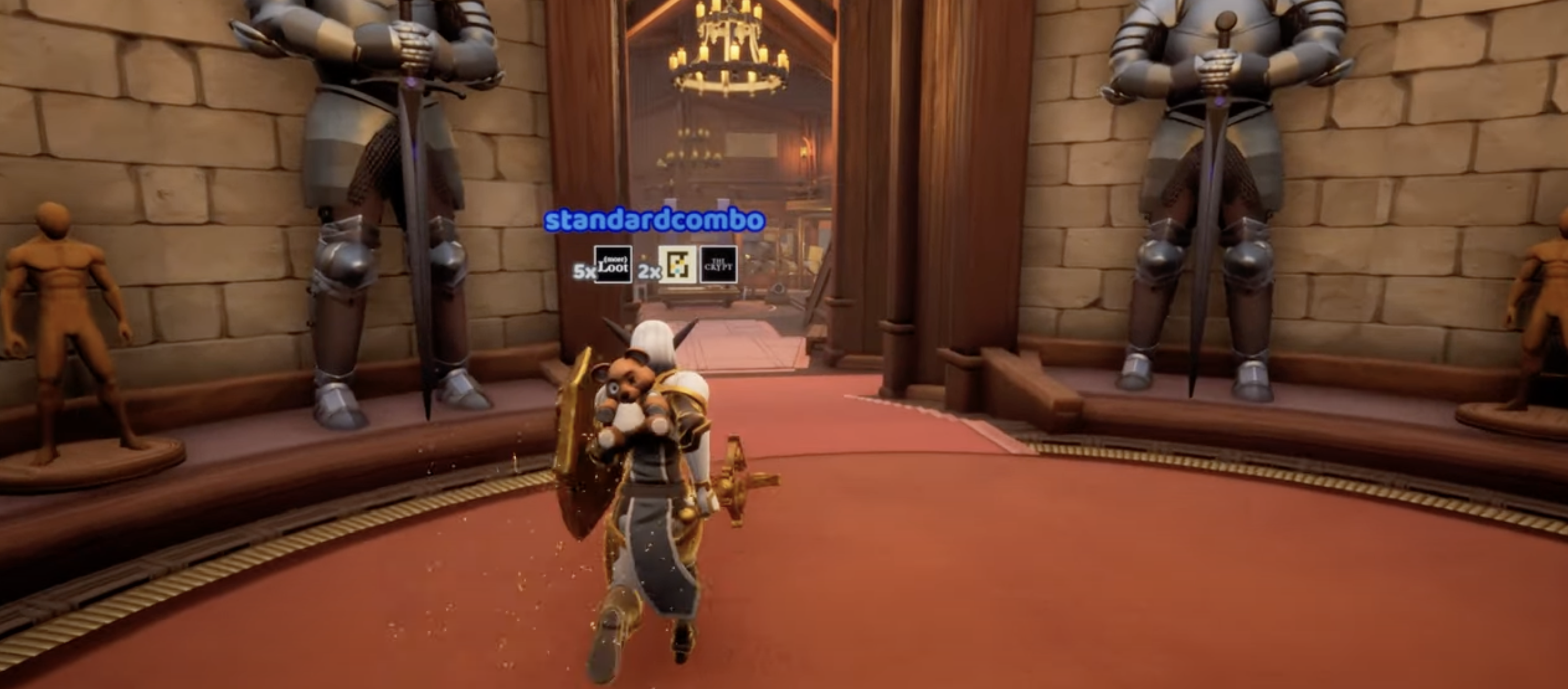
-
The Crypt Game
The Crypt is a fully on-chain game developed by web3 game studio PlaymintUK, which completed a seed round of funding of $4 million in April 2022. In order to participate in the game, players need to hold Loot, mLoot, or GA. The gameplay mechanism is relatively simple, and it involves cooperation among players to successfully complete dungeon raids and obtain NFT spoils.
Currently, the game has released three chapters, each of which has slightly different gameplay mechanics, but no further updates have been announced recently.
-
Banners
Banners is a collection of 10,600 NFTs that aims to serve as a social layer within the Loot ecosystem. It represents the factions and aspirations of Lootverse characters through specific icons and flags that carry their will.
Banners are currently active content producers within the ecosystem and are frequently seen in Scroll expansions and other written works.
-
The Rift
The Rift is a DID infrastructure for the Loot ecosystem. It assigns an experience value property to each Loot NFT, which can be obtained when Loot interacts with other projects inside the ecosystem. This experience value can be used by other derivative projects to provide extra features/airdrops for high-engagement holders.
It provides a solution for the value accumulation within the Loot ecosystem, and "The Rift" has also participated in the EIP-5050 proposal, which creates a new way to establish interaction modes between NFTs.
4. 5. Fully On-Chain version of 'Sid Meier's Civilization': Loot Realms
Realms is currently one of the most essential projects in the Loot ecosystem, and with its development, it has grown into a highly vibrant ecosystem. Realms is actively developing two full-chain games: Realms: Eternum and Realms: Adventurers!

4.5.1 Realms: Eternum
Eternum is a sandbox-style strategic simulation game similar to "Sid Meier's Civilization," which operates entirely on-chain. Players need to hold at least one Realms token in order to play the game. In the game, players take on the role of a lord of their own territory and increase the strength of their territory by acquiring and operating resources. The process involves a game of strategy among players, including building, trading, invading, and defending. It is currently live on the StarkNet testnet, and players can experience it by visiting this link.
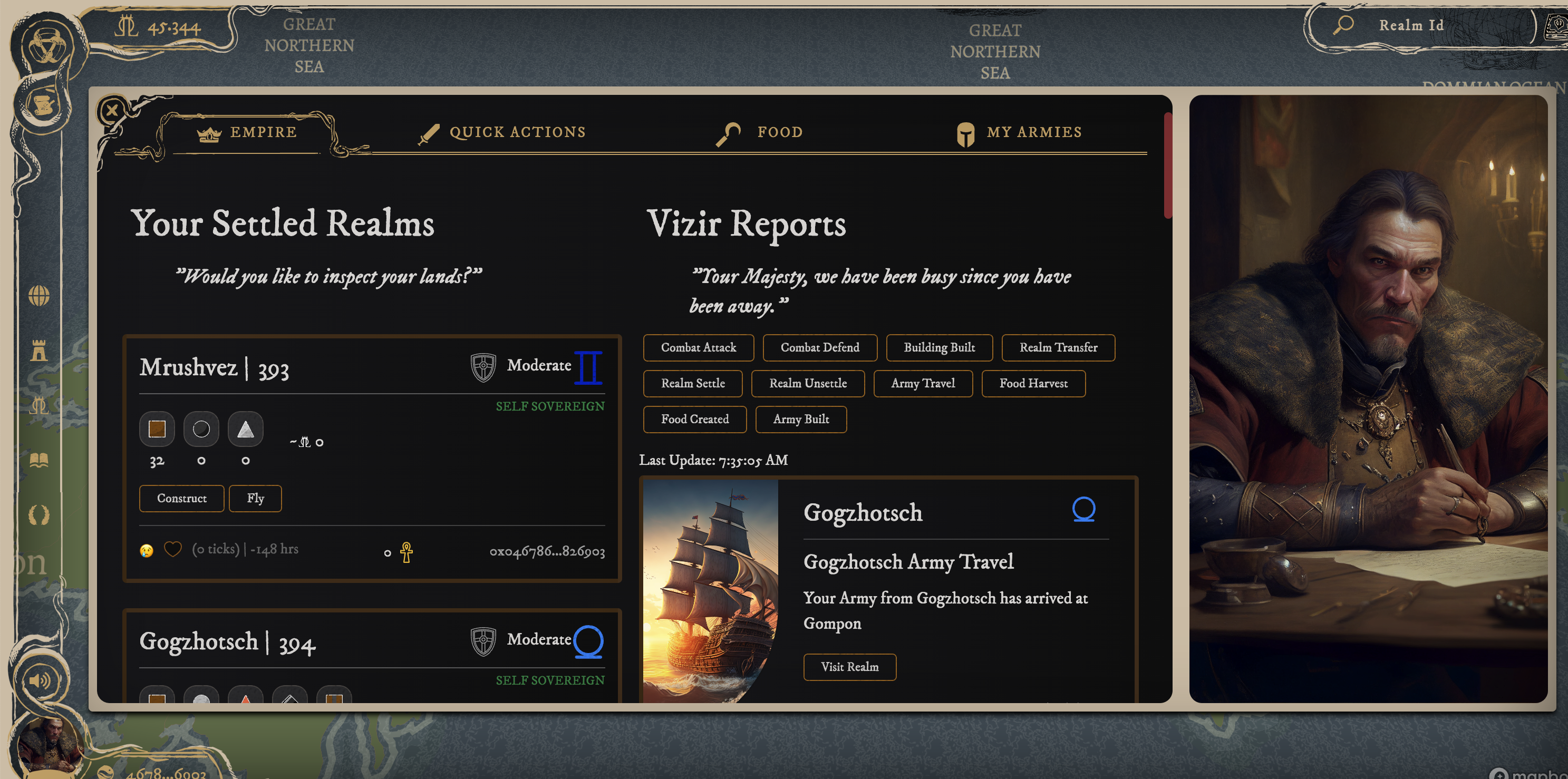
Based on the overall experience, the game already has a clear structure and gameplay mechanism. With the underlying narrative of Loot, Eternum is like the game version of "Game of Thrones". Although there is still room for improvement in terms of interaction experience and due to the current testing network limit of Starknet, which leads to long confirmation times for transactions returning from L2 to L1, Eternum, as one of the few full-chain games, still exhibits a good performance.
At the same time, its economic model has also completed preliminary design, which can form a good linkage with Loot's NFT and its own token $LORD. Once the official version is alive, holders of Realms and C&C can gain continuous asset output, and assets can also be sold for $LORD. The AMM market in the game has also been completed, and it is believed that the future economic system will present itself nicely.
With further integration into the narrative of the Loot ecosystem in the future, such as Loot, GA, and other elements, the game's modules and scale will become more enriched over time, making it a project very worthy of attention
4.5.2 Realms: Adventurers
According to information revealed by the team, Adventurers' plan is to become a fully on-chain RPG gaming platform. Within the platform, various tools are provided to enable developers to quickly integrate with the Loot ecosystem project and complete the development of RPG games, such as integrating with the dungeons of C&C. Players can operate their characters to explore different dungeons and obtain NFT assets and $LORD.
The interesting aspect is that the team intends to introduce the concept of "risk". During exploration, players can choose to take their profit and leave, or continue to explore deeper. However, once they die, they will lose a partial/all of their assets, and the corresponding NPC or developer will receive this portion of assets as a reward (might be the holder of C&C). The team refers to this mode as "Play 2 Die", which enhances the overall competitiveness of the game.
However, since Adventurers is still in the closed development phase, the concept is still being validated, the final presentation needs to be awaited.
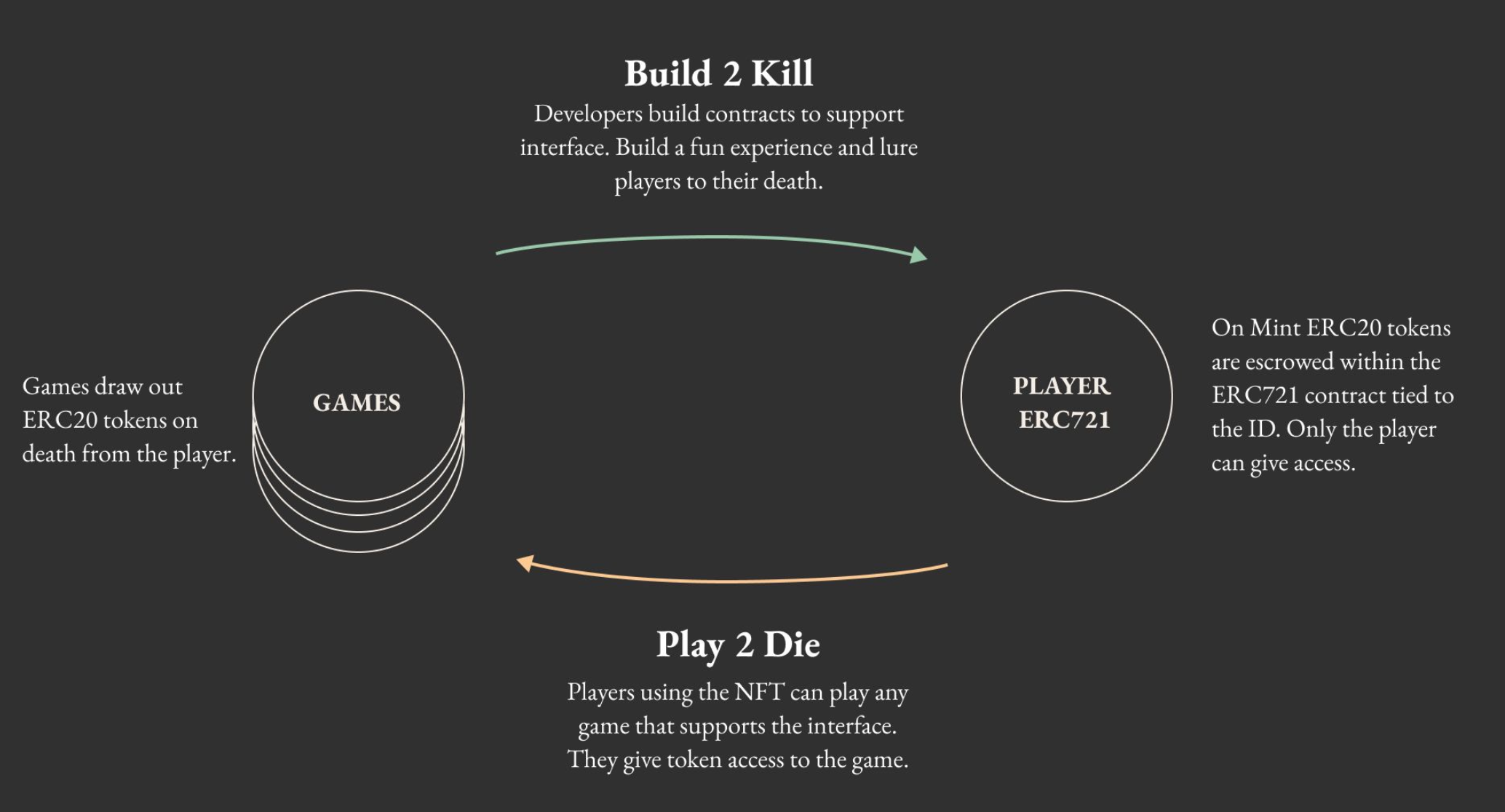
Finally, the entire Loot ecosystem has started to collaborate more with Starkware. As a gathering place for on-chain games, the "on-chain Steam" Cartridge in StarkNet and the "on-chain game incubator" MatchboxDAO are also objects worthy of attention.
6. Dark Forest and Loot
In the previous section, we elaborated on two crucial projects in fully on-chain games, helping us get a basic understanding of the concepts. Now, by analyzing their similarities and differences, what insights could we gain into the overarching theme of fully on-chain game?
6.1 Differences in "Narrative": Rules vs. Clues
The narrative is undoubtedly the most important part in the content industry, and the nature of decentralisation in blockchain technology has been utilized by Dark Forest and Loot in distinct ways to create two different forms.
Loot, as previously mentioned, abstracts words into infinite possibilities for the worldview and universe rules. It only provides players with "clues" to basic elements and gives the entire power of interpretation to each participant. In this process, players can not only explain and visualize the "clues" (e.g., GA and Hyperloot) but also associate them with other related elements (e.g., Loot Realms) and create bridges between different "things" (e.g., The Rift). This allows Loot to grow into a content universe entirely built by the participants themselves. This is precisely the inclusivity that the "bottom-up" model can unlock for all possibilities.
In contrast to Loot's boundless approach, Dark Forest focuses more on the development of gameplay. Therefore, Dark Forest adopts a "top-down" approach. But unlike traditional NFT or game projects that offer a complete game narrative, Dark Forest only establishes the core "universe rules" and basic elements. By open-sourcing and putting it on the blockchain, it allows everyone to enrich the "experience" under a framework. This enables Dark Forest players to focus more on the game itself without having to establish a consensus on the rules again. This approach also creates a highly dynamic community ecosystem.
6.2 Differences in "Gameplay Logic": Achievement vs. Experience
Different narrative frameworks correspond to different purposes. As an MMORTS game with clear mechanics, Dark Forest's major purpose is to provide a scene for players to "game", allowing them to fight and strategically confront each other within limited resources in order to achieve victory. Therefore, for players, their main goal in participating in Dark Forest is to use various strategies to win and taste the "achievement".
In this process, due to the characteristics of the fully on-chain, players tend to increase their chance of winning by developing plugins to get extra advantages. This spawns a vibrant developer ecosystem and also creates a type of "achievement" which could be achieved by the creation of high-quality plugins. Therefore, it can be found that the ecosystem of Dark Forest is based upon the achievement brought by "gaming" and "derived development".
Loot is different. To some extent, it is not really a "game", or it greatly surpasses the concept of a "game." Loot does not have a specific purpose from the beginning. The core is "experience", and gaming is just a part of that whole experience. Anyone who has drawn RPG from a draft book when they are still a child or who has ever played "Dungeons & Dragons" should know the potential of the concept of "clues", it would be so easy for a game to be constructed based on it.
However, the potential of Loot is far beyond just one game. It can give rise to countless games, game components, or just stories. Because of this broadness, for the participants, it is like "travelling through different worlds", and the "experience" they can gain will be the most unique things that the Loot universe would provide.
Therefore, if we compare narrative and gameplay, Dark Forest is more like the on-chain version of "The Three-Body Problem", while Loot is like the on-chain version of "Game of Thrones".
6.3 Differences in Economic Mechanisms: "Concentration" vs. "Connection"
In this context, the two mechanisms are quite similar to some extent. The primary purpose of an economic mechanism(or tokenomic) is usually to attract new participants while providing incentives to retain and reward existing contributors. But both Dark Forest and Loot do not rely on their economic models to generate traffic.
However, Dark Forest is distinct in that it has clear game mechanics and objectives, with "rules" at its core. The design of the rules did not include a tokenomic, as the team prefers to focus on exploring the game mechanics. As a result, creating a new tokenomic and gaining approval from the whole community become a relatively difficult task. This filters out lots of speculators and allows the game to be more "pure". This pure motivation more effectively inspires players to think, explore, and build.
Compared to Dark Forest, Loot has a broader audience and ecosystem, its growth is not limited by any rules. Even new ecosystems are born inside the Loot ecosystem, resulting in the emerging of various project/ecosystem tokens that connect each other (such as fundraising and integrating other tokens), as well as effective incentives for contributors.
However, such tokens might involve governance issues, the recent case of "Uniswap deployment" which undoubtedly sounded an alarm on the topic of "token governance". As such, the extent to which ecosystem tokens could help remains a matter that still needs to be observed and studied.
7. Thoughts on Fully On-Chain Games
7.1 Current Challenges
Up to this point, we have dedicated thousands of words to outlining the overall features and important characteristics of full-chain gaming. But does "Fully On-Chain" necessarily means the "right" path for blockchain games? As of now, it is slightly premature to say so. Despite the potential of fully on-chain games, there are still many challenges that need to be addressed:
-
Insufficient underlying infrastructure: The underlying infrastructure mainly consists of the chain and the corresponding development tools. This infrastructure impacts the game in terms of latency, cost, and iteration.
-
Latency: As previously mentioned, massively multiplayer online games are often very sensitive to network latency and stability. The high-frequency transaction processing required for blockchain performance places very high demands on the network.
-
Cost: The cost includes both the development cost of the game and the on-chain interaction cost for the players. As the industry is still in its infancy, there are no mature web3 game engines such as UE and Unity, which makes the work of developing full-chain games even more substantial. Additionally, as all transactions on the chain the gas fees might also become a burden for players, especially given the current complexity of the concepts of 'wallet' for web2 users.
-
Iteration: The permanent nature of the blockchain brings fairness and decentralization, but it also poses certain challenges for code iteration. Developers need to carefully audit their code to ensure that there are no vulnerabilities and all the gameplay funcion & logic is correct, which is a very labor-intensive task for any game with a slightly larger volume.
-
-
Selection of game types and gaming logic design:
If we simply classify game types, they can be broadly divided into RPG (role-playing games), ACT (action games), AVG (adventure games), SLG (strategy games), and SIM (simulation games). At present, most full-chain games are limited to SLG games that emphasize strategy.
Firstly, in terms of single-player versus multiplayer games, fully on-chain games will have more expectation on real-time online multiplayer. The features of fairness and openess from fully on-chain will not be maximized, if it is only a single-player game, the OCA mode of asset on-chain seems to be more efficient, such as the Beacon. Therefore, single-player RPGs and most AVGs are basically passed over (although there is still potential for exploration in 7.2).
In traditional game development, for games that emphasize real-time combat, such as ACT and MOBA, frame synchronization or event triggering is usually used to handle player interactions and status, in order to complete a large number of transaction processing under low network latency. However, the performance of the current blockchain is still very difficult to achieve that. Therefore, for the time being, game types that are relatively suitable for realizing "fully on-chain" are majorly SLG games that emphasize tactical deployment (such as Dark Forest) and those that emphasize experiential SIM (such as OPCraft).
However, even for these types of games, there are still many challenges. For example, for open-world building SIM games like Minecraft, UGC content is an important part of the building experience, so a game engine that can support the corresponding logic would be a major difficulty.
As for SLG games, the challenge lies in how to convert the gameplay logic into a form that can be implemented on the blockchain. This involves resource planning and game processing. For example, Dark Forest slows down the game pace and reduces player operation frequency by extending the energy transmission time, thereby reducing the pressure on blockchain performance. This is a very clever way of doing it. However, throughout the development process, the gaming logic of Dark Forest also faced numerous challenges, such as game balance and the appeal of game mechanics.
Therefore, the concept of being "fully on-chain" still presented significant challenges in the early stages of game planning and development.
-
Challenges Posed by the Features of Fully On-Chain:
All things in life have their duality, just as "centralization" means efficiency but also might implies monopolization, and "fully decentralization" brings "freedom" but may also lead to "chaos".
At the narrative level, the unrestricted user-generated content and free narrative framework have indeed expanded the boundaries of content. However, when anyone can participate in the narrative process, the quality of the content will inevitably vary.
On the one hand, the advancement of the overall narrative will be slowed down by the community's screening and review of the content, leading to a decrease in efficiency. On the other hand, when a large number of narrative branches emerge, they will blur and disperse the focus on high-quality content, causing community members' attention to become scattered and leading to a longer time to establish the corresponding consensus.
In addition to the aforementioned challenges related to the experience and mechanism design, new perspectives are needed in terms of the economic model. Moving the game fully on-chain indeed provides the greatest openness and composability of the economic system, but it also means that the ability to regulate the game's economic system is almost completely lost. This will bring about significant variables for the game's future development.
7.2 Hopes and Expectations
Given the numerous challenges facing the "fully on-chain" gaming industry, why is it still worthwhile to pursue? Alternatively, what are our expectations when we discuss "fully on-chain" gaming?
What is most exciting about fully on-chain games is their ability to broaden and break through traditional definitions of "games," unlocking entirely new dimensions of possibility and providing players with a different "experience." This experience stems from the "permissionless interoperability" that comes from being fully on-chain.
Imagine, for example, if World of Warcraft suddenly opened up a Minecraft dungeon, and the equipment obtained could be used as skins in Dota, where the achievements in Dota could then be converted into Game ID experience and badges, thereby unlocking a special card in Magic: The Gathering. Such cross-game, cross-platform, cross-category, and cross-world linkage will be available for anyone to achieve, and the highly interoperable and composable features of the game concept create a much more open and wild ecosystem and richer combinations.
Moreover, the importance of storytelling in gaming cannot be ignored. This is especially apparent to Chinese World of Warcraft players, who understand the profound and lasting impact of a well-told story on a player's experience. It is why NetEase was able to successfully attract millions of players with only one server of the WoW veteran expansion after the game's closure. The tamper-proof feature that naturally comes with fully on-chain gaming also provides a fair and permanent soil for storytelling.
As players, we will always yearn for greater openness, more flexible combinations, and more unique narrative structures. This is why The Legend of Zelda could become a legend in the gaming field. And Lego, a simple block game, have become popular worldwide for nearly 90 years. It may be difficult to fathom that just 6 simple 8 studs LEGO bricks can produce over 900 million possible combinations. With blockchain technology, we can unlock the potential to create the LEGO version of gaming with highly combinable and expandable features, which should be highly anticipated by all gaming enthusiasts for the imaginative possibilities it could inspire in the future.
7.2 Future Possibilities and Directions
In light of the current overall development of blockchain technology, as well as the inspiration provided by Dark Forest, Loot, and other on-chain games, there are numerous promising directions for future exploration. As such, I would like to briefly introduce a few potential possibilities:
7.2.1 Infrastructure and Tools
-
Game Engine
A game engine plays an extremely important role in the development of any large-scale game, and for fully on-chain games, it is equally important to have a tool that can help developers quickly deploy game logic. This not only shortens the development time but also provides a data standard to facilitate subsequent iterative development by others and cross-calling in the open ecosystem.
Currently, the relatively mature project in this field is the Solidity-based on-chain game engine, MUD, developed by @Lattice studio. It enables developers to quickly deploy game logic to the contract and provides significant improvement in development efficiency through the synchronization of contract and client status.
Interestingly, besides Solidity, Cairo from Starkware is also a commonly used language in the development of fully on-chain games. Since MUD cannot be well compatible with Cairo, the founders of two active projects in the Starkware ecosystem, Realms and Briq, jointly developed an on-chain game engine called Dojo based on Cairo. However, due to the similarities in the core ideas of Dojo and MUD, Ludens, the founder of MUD, expressed some objections, which causing a small controversy. Nevertheless, Ludens still expressed his willingness to assist in deploying MUD to StarkNet.
Although MUD is an excellent framework and has developed fully on-chain games such as OPCraft, it is still an area with much room for exploration and development as the underlying infrastructure for game development.
-
Game ID
Game ID refers to the DID generated by players based on the game, which mainly represents the reputation and skills of the player. This direction can encompass a wider range of game types, not just for fully on-chain games. For example, projects like DeQuest and Carv belong to one of the implementation methods of Game ID, and projects like the Rift are more focused on the identity within a certain ecosystem.
The reason why Game ID is important is that it is a tool that can link players with various different games and ecosystems, it is an indispensable tool in the process of gaming ecosystem construction.
-
Distribution Platform
Distribution is an extremely important part of the game industry, as it is the bridge that links game developers with users. The more open the ecosystem, the greater the demand for such roles. From the development history of games, we can see that STEAM and EPIC have seized the opportunity of the transition of games from consoles to PCs. Therefore, we can also believe that there is great untapped value in the trend of combining games with blockchain.
Currently, there are many launchpads and platforms that combine launchpads and Game ID for ordinary chain games. Among them, projects that are worth paying attention to include TreasureDAO in the Arbitrum ecosystem, which aims to become the web3 Nintendo, and Cartridge in the Starkware ecosystem, which aims to achieve web3 Steam.
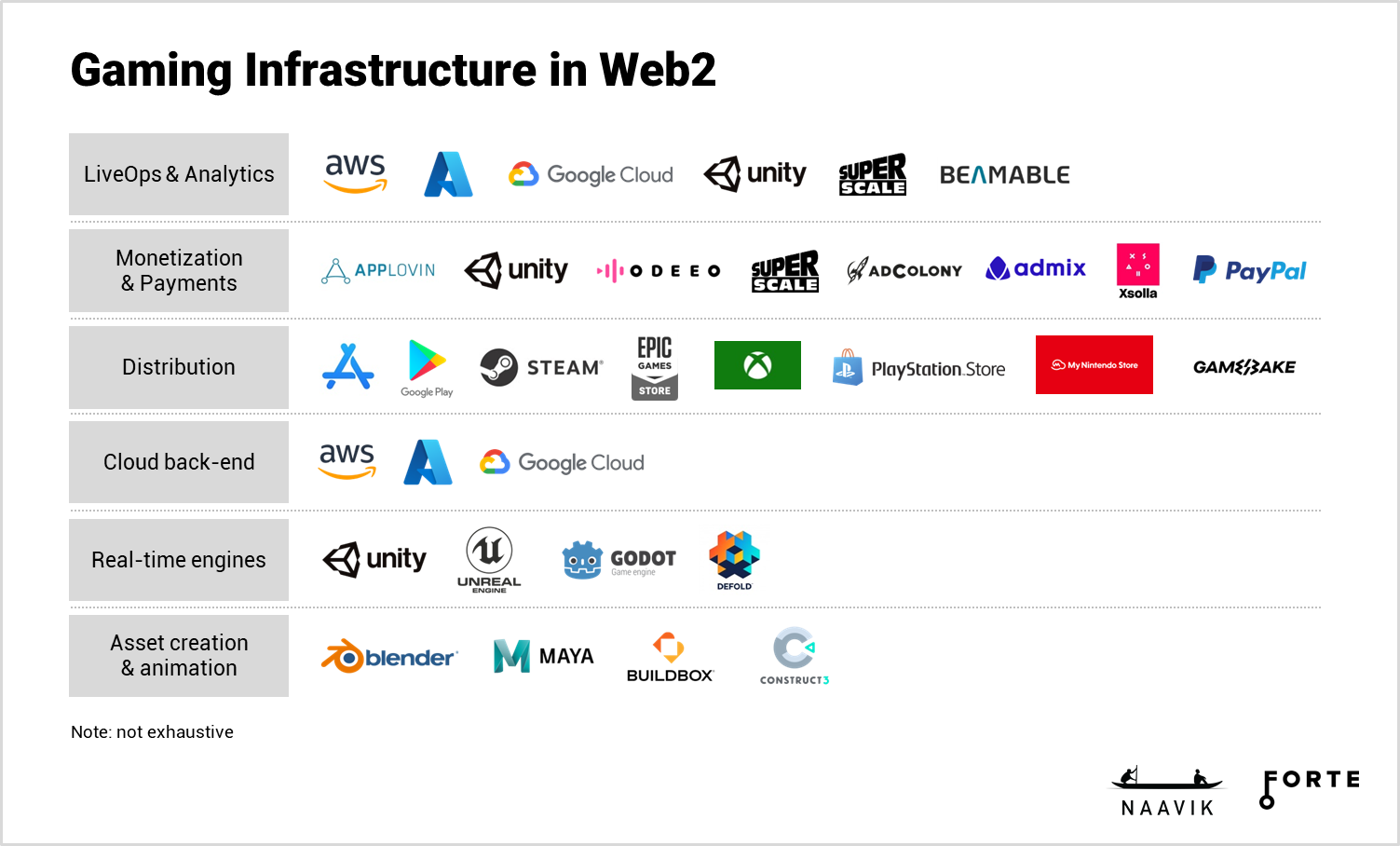
-
Strategy Games (SLG)
SLG games are undoubtedly an excellent fit for the concept of a fully on-chain game. On the one hand, they can provide a complete gaming experience in an environment with low requirements for graphics and real-time combat. On the other hand, their high degree of narrative inclusivity enables games to offer both deep narratives and magnificent backgrounds, such as Loot or Realms, or simple narratives and strategy, such as Dark Forest, or purely gambling games like zkHoldem (on-chain Texas hold'em).
In terms of game mechanism, the cooperative style is also a very interesting type for on-chain games. For example, Topology's ISAAC or maybe a fully on-chain version of Plague Inc. Board Games and 18xx games would also be excellent themes to explore.
-
Role Playing Games (RPGs) and Adventure Games (AVGs)
As mentioned earlier, single-player games often struggle to fully utilize the characteristics of the entire blockchain ecosystem (excluding MMORPGs). However, this does not mean that it is impossible, rather, it requires more sophisticated thinking and design. For example, puzzle games in the AVG category are well-suited for the context of the entire blockchain ecosystem and zero-knowledge proofs. The former project, PLUR, was a very interesting attempt (although not a full-fledged blockchain game), and you may want to take a look at it via this tweet.
In terms of RPGs, Realms: Adventures proposed some great ideas. Players complete single-player challenges in a dungeon similar to Beacon, but in reality, players are engaged in a game of strategy with the creator/owner of the dungeon through their interactions with it. Introducing an asset and economic system in this context can also create a very interesting picture. Additionally, narrative-driven themes like Call of Cthulhu and Dungeons & Dragons are also worth exploring.
-
Simulation or Exploration Games that are linked to the Real World
One of the most important features of blockchain technology is the ability to permanently record and store data, and there are many meaningful attempts that can be made in this regard. For example, Guardians of Earth is a real-world exploration game that has deep involvement and investment from Dr. Jane Goodall. Similar to Pokemon GO, it encourages players to find, explore, and record rare animals and plants they discover in the real world and to earn "capture" rewards. These records can help rare animals and plants receive better recognition and protection.
Although it has not yet been fully implemented on-chain, the overall logic of such games is not complex, and the content that is put on-chain is very valuable. The entire reward mechanism can also be implemented fairly through an on-chain economic model, making it a direction worth exploring.
8. Ambiguous Boundary Lies Between"NOW" and "FUTURE"
As the concept of web3 gains increasing attention and more products embracing decentralization continue to emerge, we are hearing more and more voices comparing the user experience of web2 and web3. Such comparisons are undoubtedly valuable, as they enable founders, product managers, and investors to gain a clearer understanding of where web3 applications currently stand and what areas require improvement.
However, this does not imply that all products failing to meet or exceed the user experience of web2 are meaningless or without value. We must bear in mind that we are attempting something entirely new, from the underlying technology to product logic, as we strive to construct a new world.
The value of comparing web2 and web3 should be limited to helping us understand the current progress. Otherwise, it would be akin to pitting an F16 fighter jet against an F1 racing car in a 100-meter dash, with the F16, designed as a combat aircraft, ultimately losing. Can we really compare these two entities when their purposes and directions are so vastly different?
Whether it is a fully on-chain game, decentralized social network, or the network state,, these current niche, even ridiculed experimental concepts, ideas, and products may well be the starting point of a new revolution, a new era. Let's give them more tolerance, encouragement, and constructive opinions to help them grow, as the shift in paradigms often occurred inadvertently.
Appendix
-
[[JumpCrypto] Gaming Infrastructure Part 1: Defining On-chain Gaming]](https://jumpcrypto.com/defining-on-chain-gaming/#:~:text=Approach %231%3A Fully on-,a shared state on-chain)
-
[Will Robinson] Unblocking On-Chain Games: Part One — Throughput
-
[NAAVIK] An Introduction To Blockchain Gaming Infrastructure
-
[MIT Tech Review] This sci-fi blockchain game could help create a metaverse that no one owns
-
[Devcon Bogotá] Dark Forest: Lessons from 3 Years of On-Chain Gaming by gubsheep
